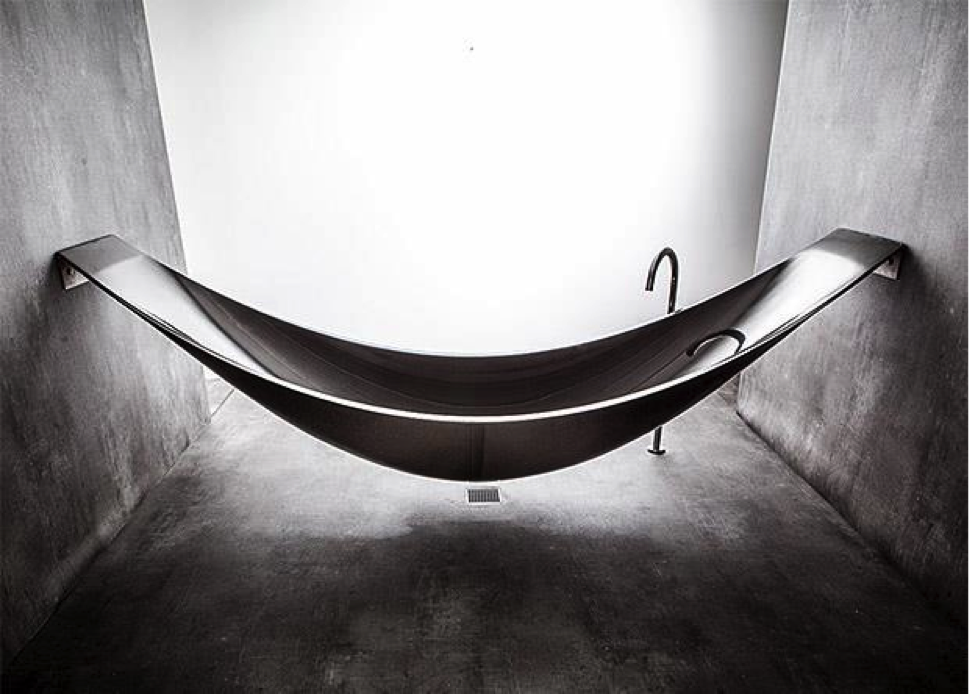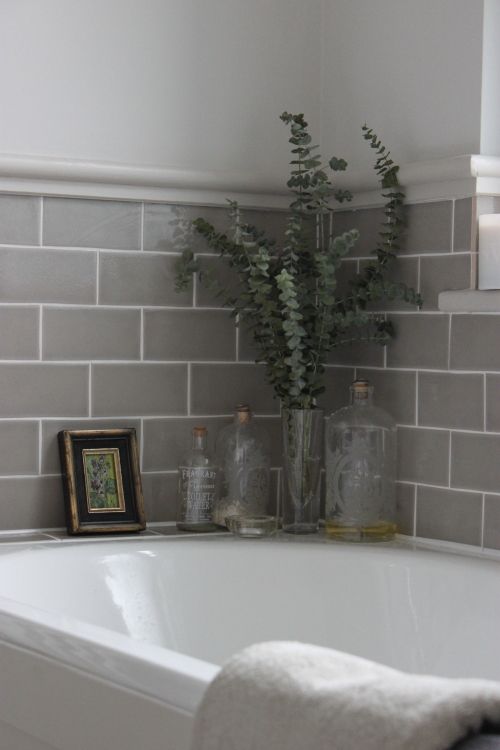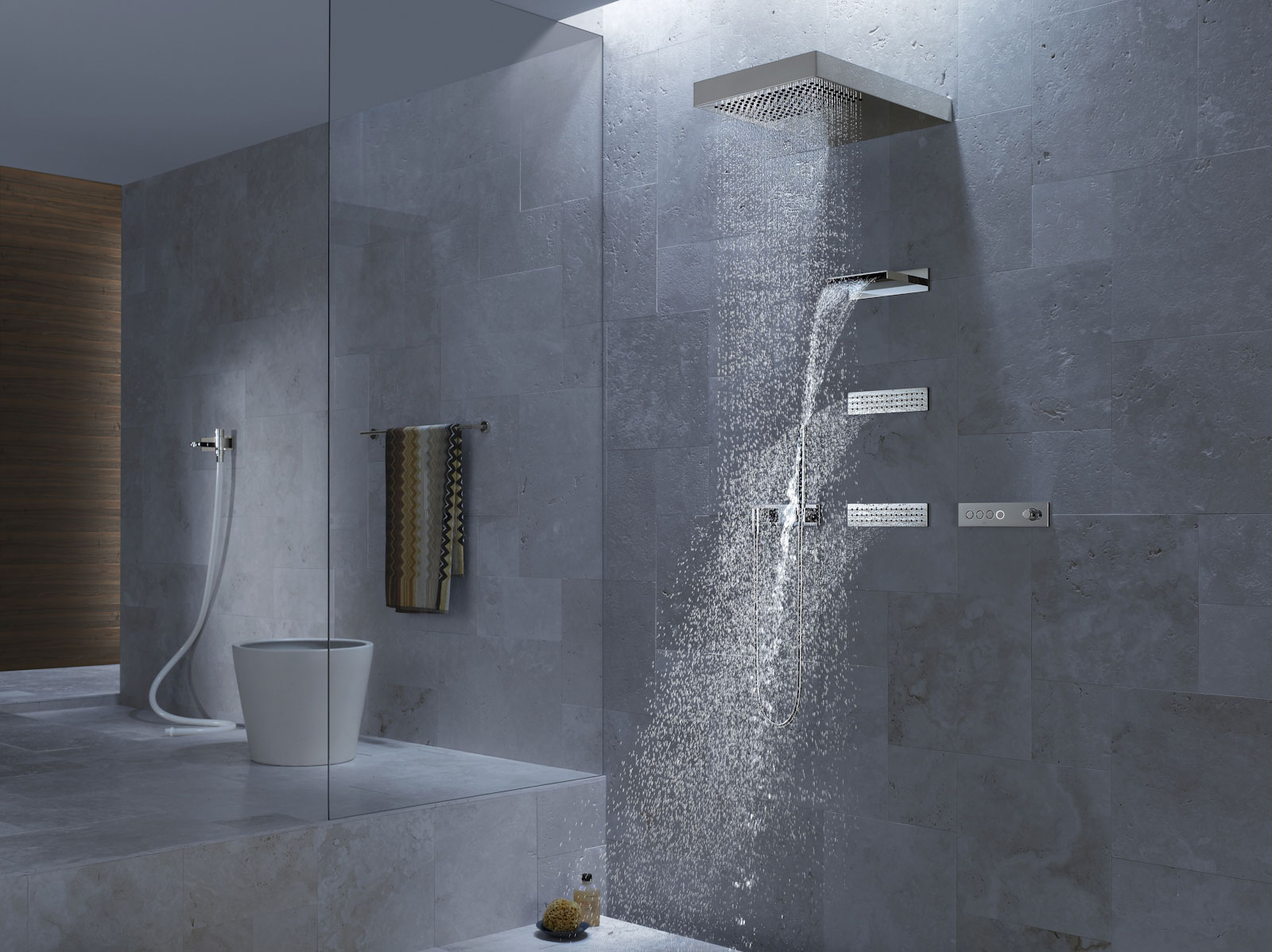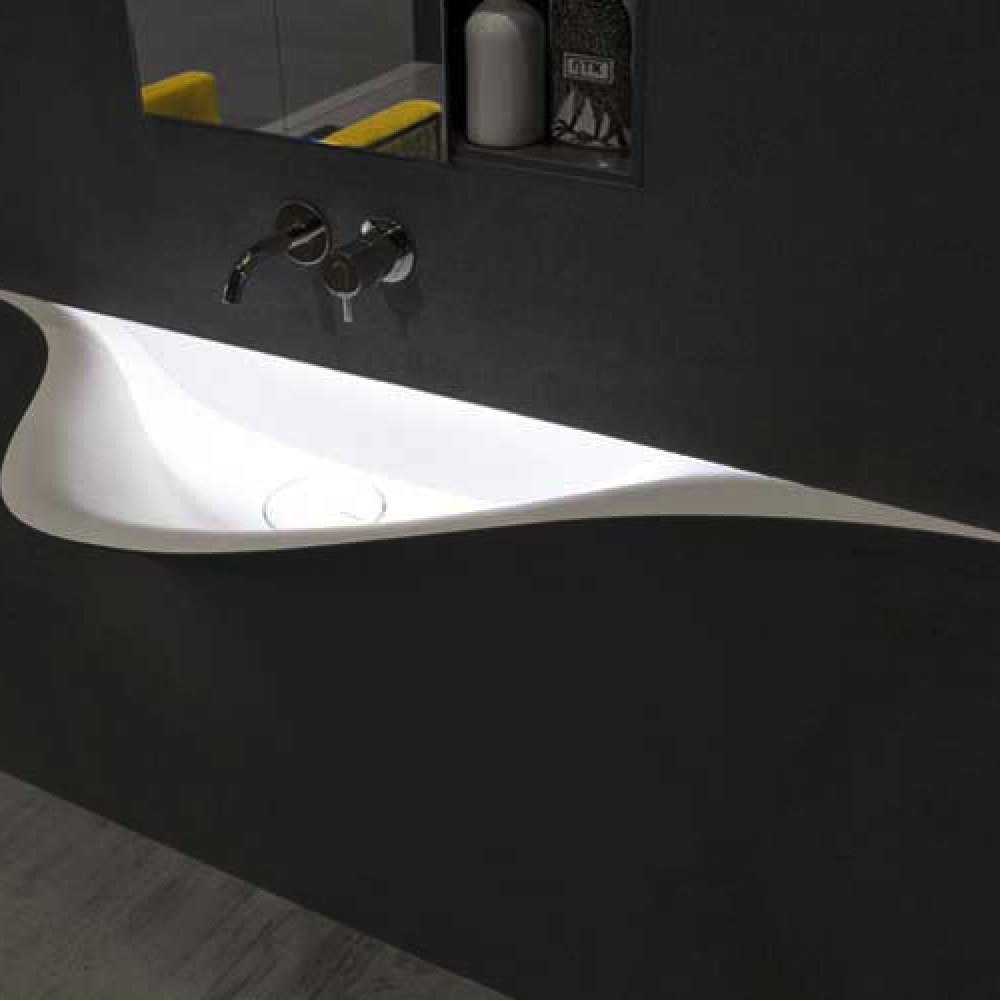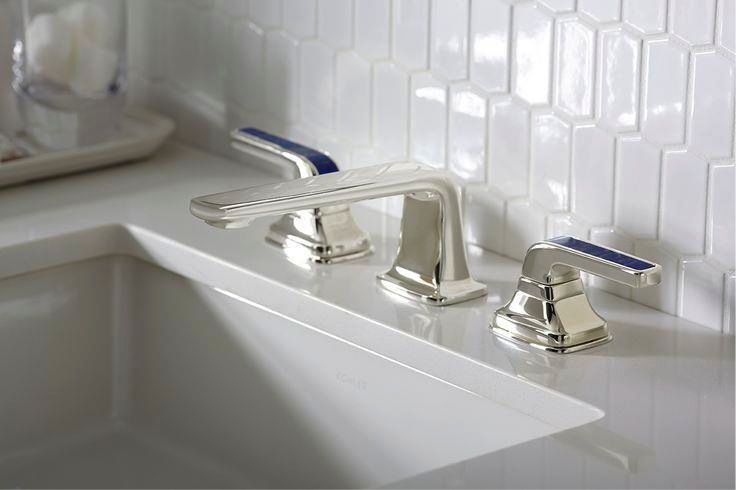


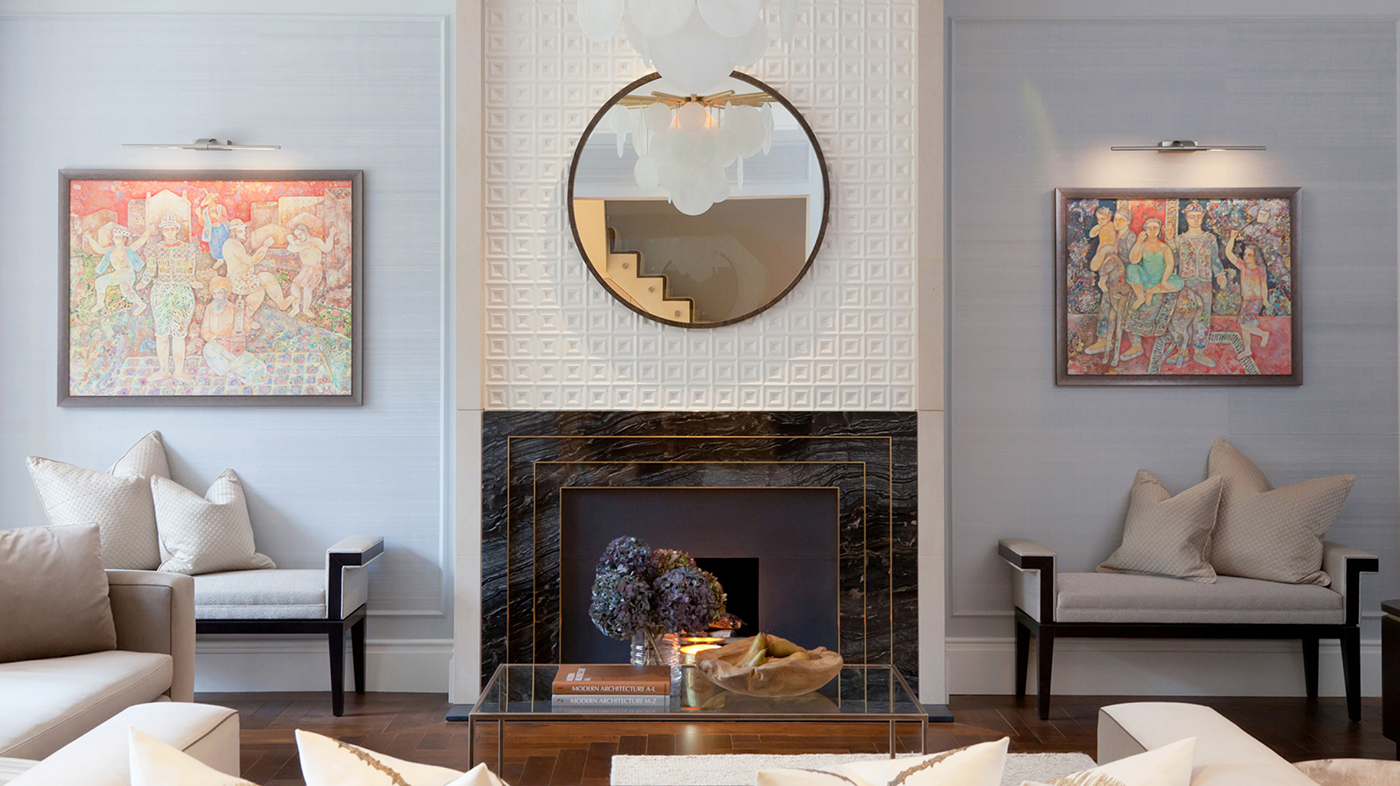

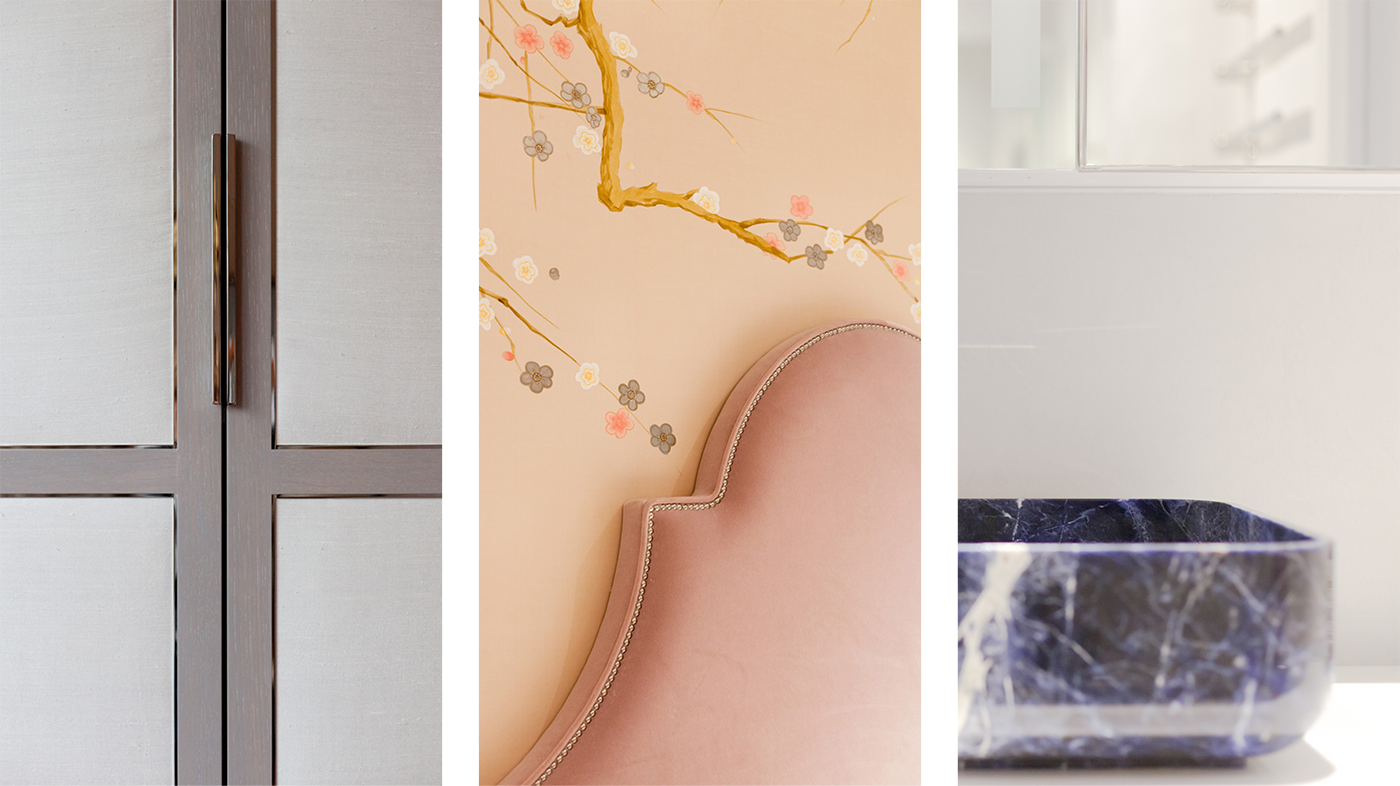
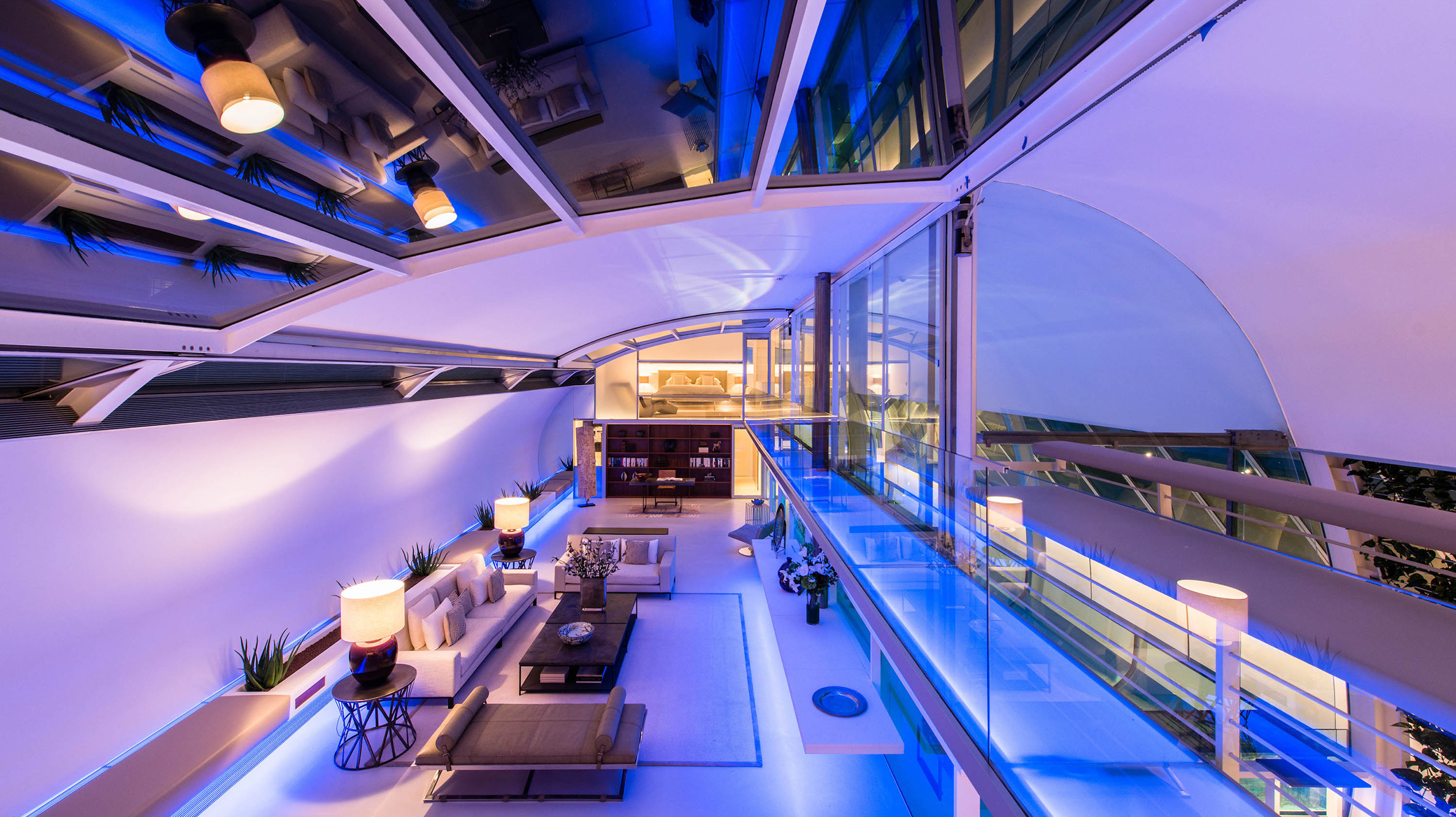
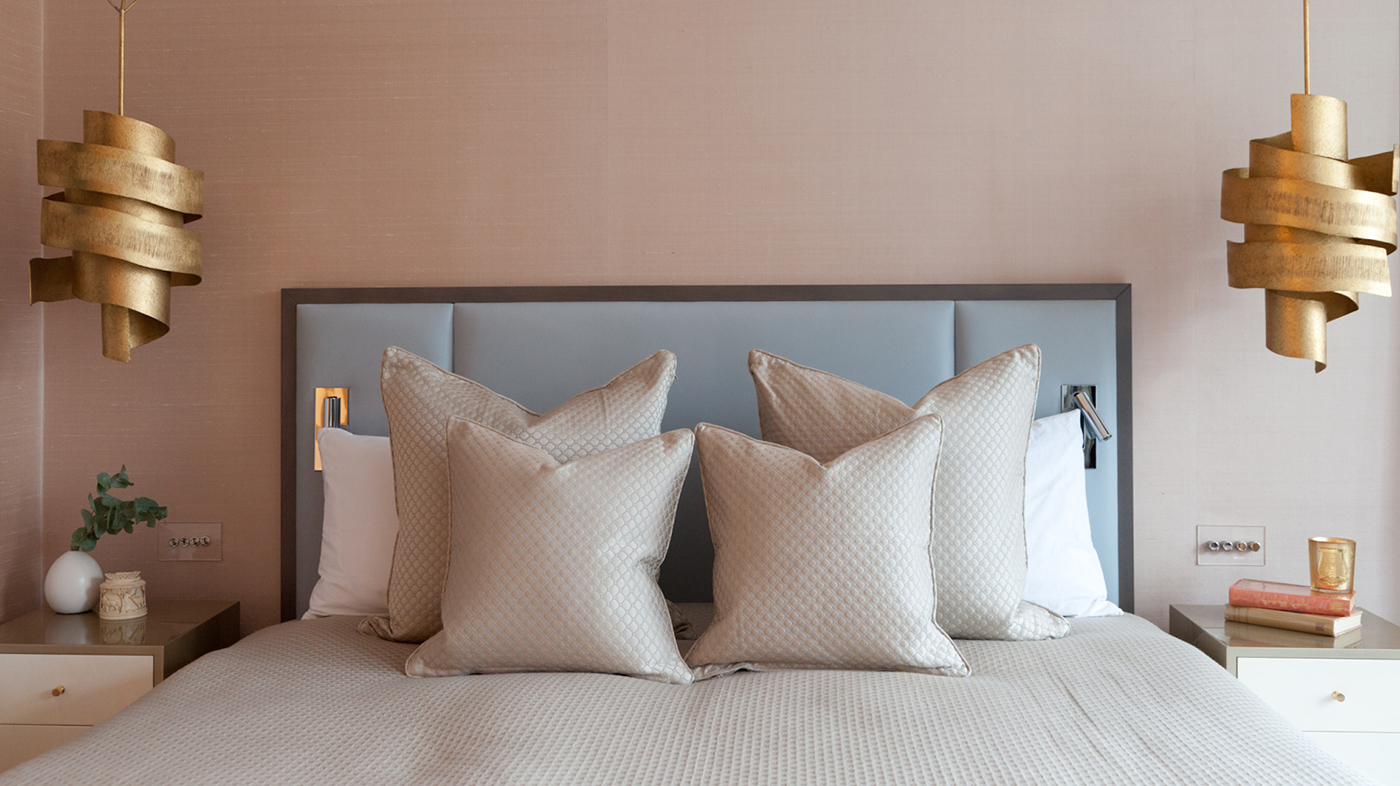
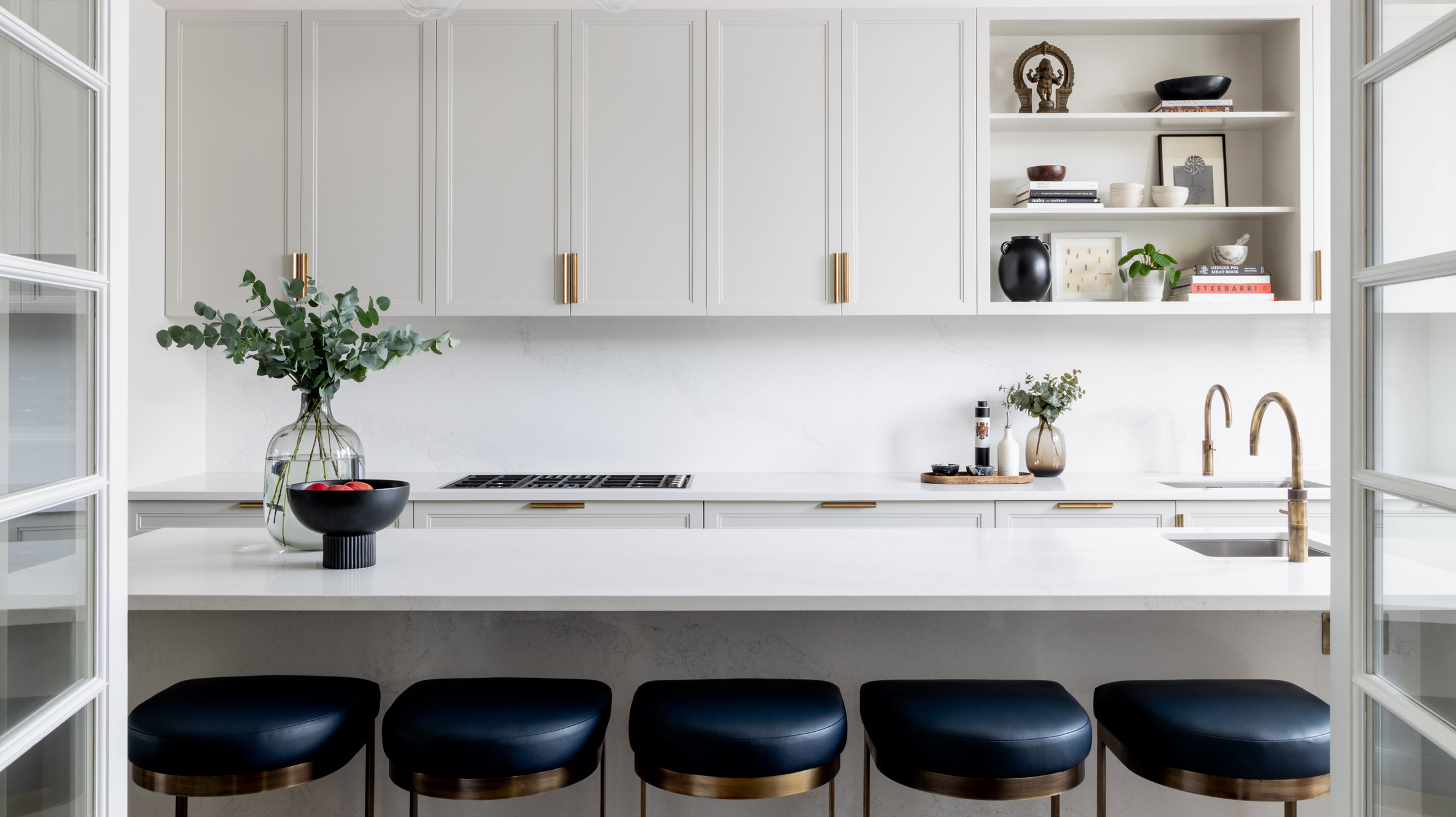
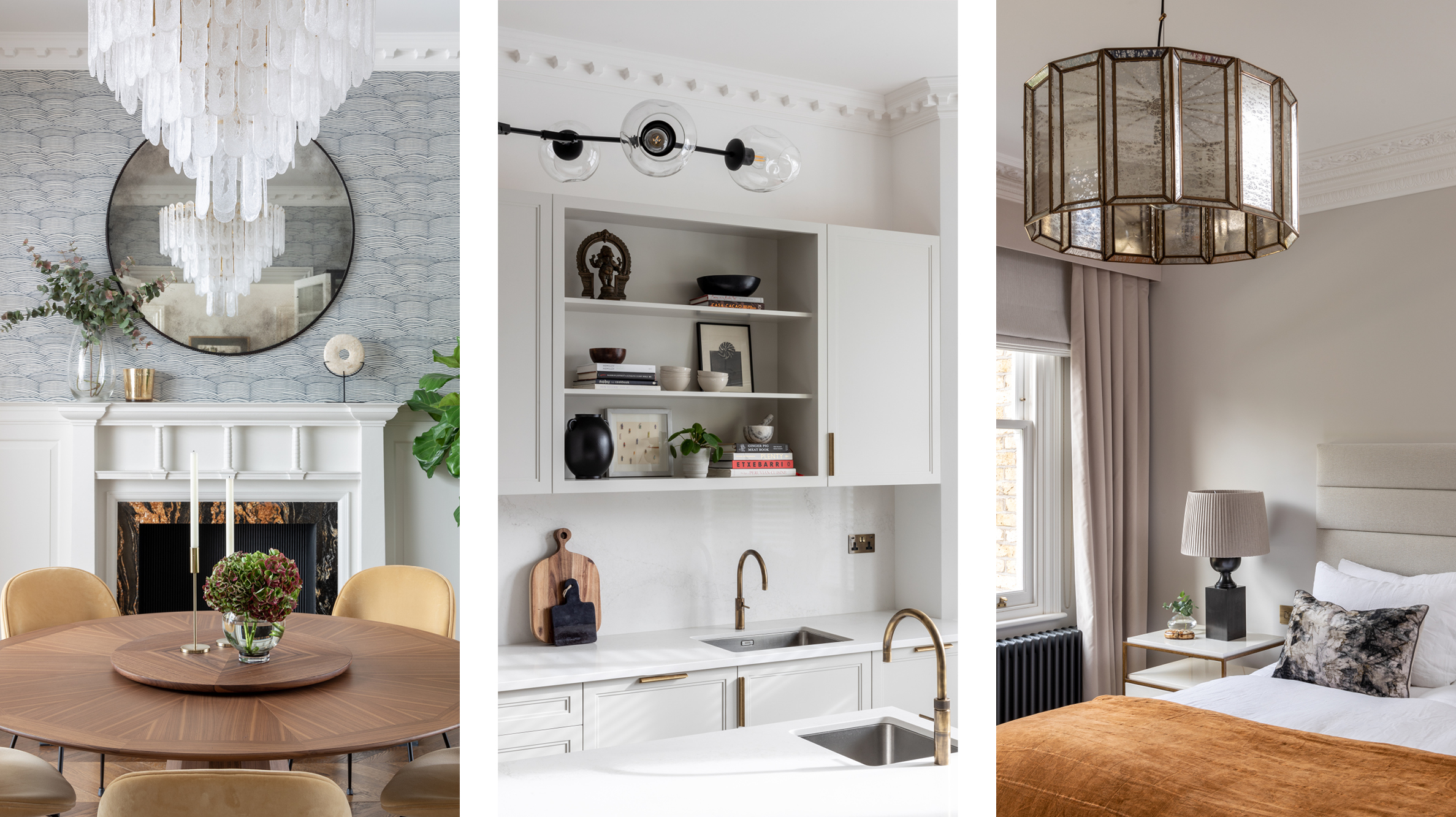




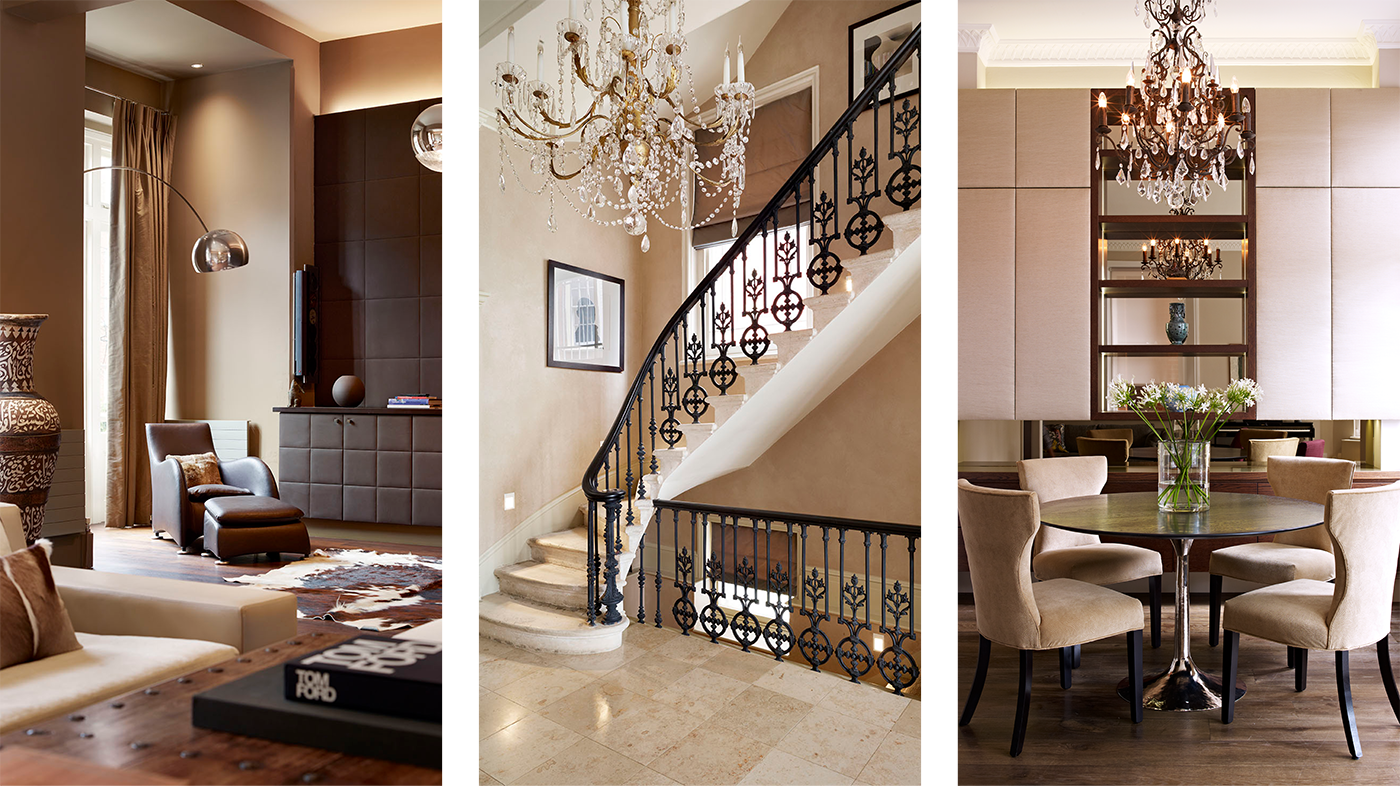
Côte d'Azur • London • Los Angeles • New York • Paris
California Design and Inspiration
West Coast Wonders
On a recent trip to Los Angeles to visit two of our newest interior design projects in Ojai and Laguna Beach, we found LA brimming with design inspiration and fabulous sourcing.
Unlike our other projects in London and the French Riviera, California holds its own melting pot of creative energy threaded throughout its laid-back yet chic lifestyle.
We are California dreaming!
Listen to our latest interview on Riviera Radio where Mark Howorth expands on our new projects in California.
The first interior design project is set in the serene sleepy landscape of Ojai just between Los Angeles and Santa Barbara. Ojai is renowned as a Shangri-la of well-being, spirituality, and art infused with earthy organic energy.

From a design point of view, we are looking to create an effortless interior reflecting the serenity and understated sophistication of this slow-paced affluent utopian town.
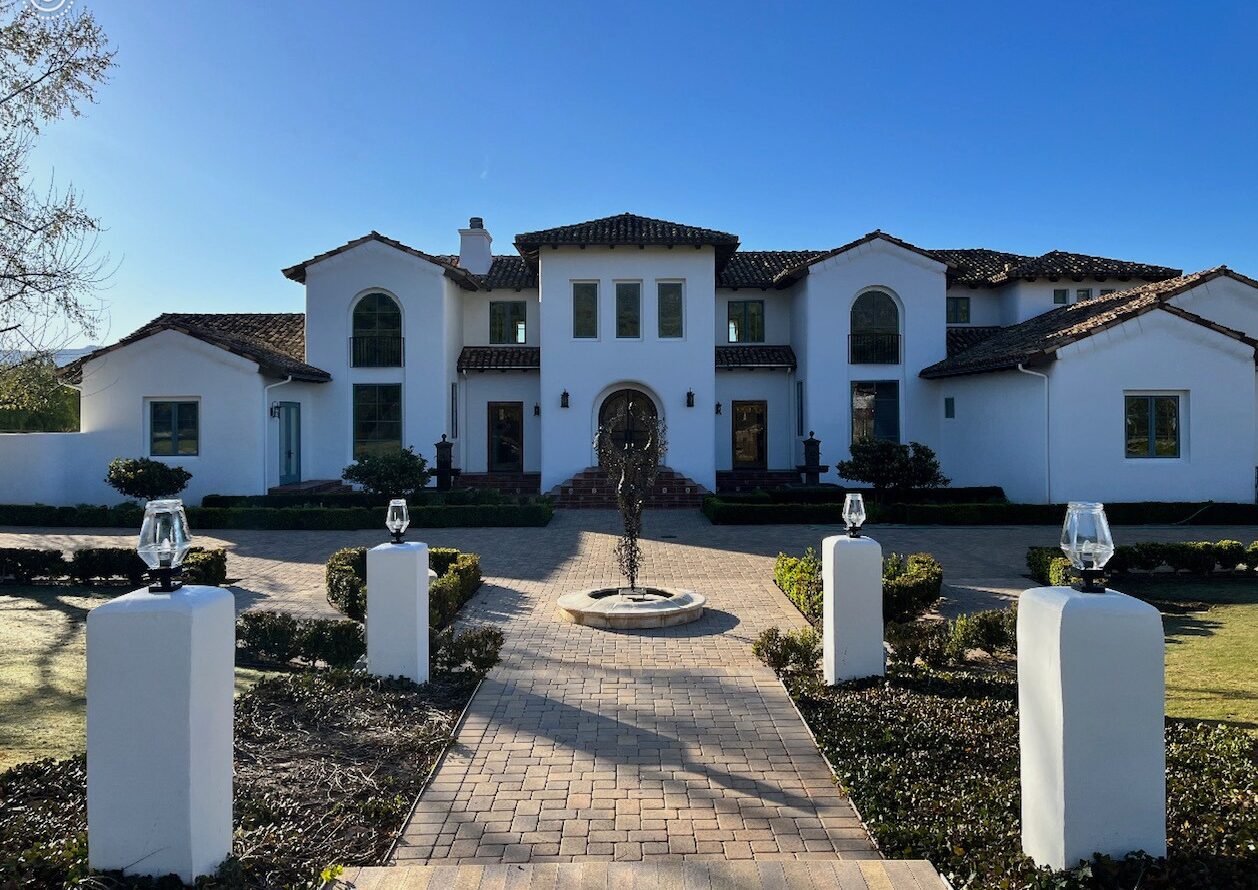
The second interior design project is set in the vibrant beach town of Laguna Beach.
The breathtaking beaches with their crystal-clear waters, pristine sandy shores and rocky coves with year round surf sets the tone for this upscale coastal community.

Famed for their thriving art scene largely due to the Laguna Art museum.
Originally opened by Edgar Payne in 1918, and their events and festivals, has culturally shaped Laguna Beach as a prime address for an idyllic healthy sun-kissed lifestyle with uptown appeal rich with a storied art culture.

@Laguna Beach House
For this project, our design team will draw on the essence of beachside living and a stylish coastal aesthetic design maximising the light of the warm California sunshine.
Sourcing inspiration in LA
Los Angeles is a melting pot of creative inspiration.
Melrose and the Pacific Design Centre are great areas for sourcing, we truly appreciate the American energy and service.
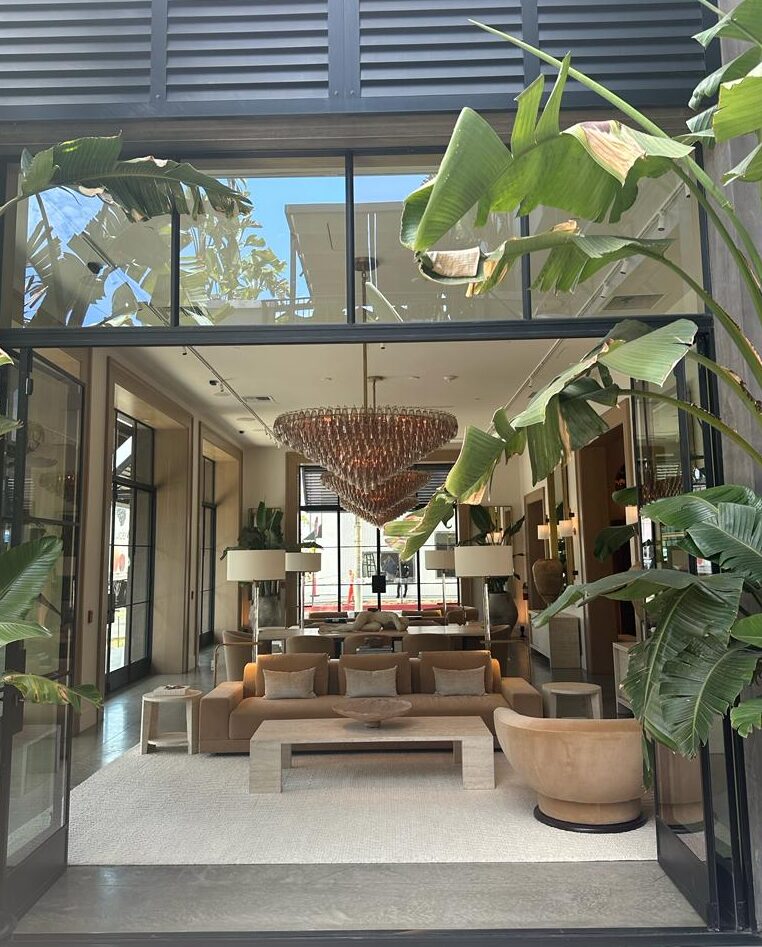
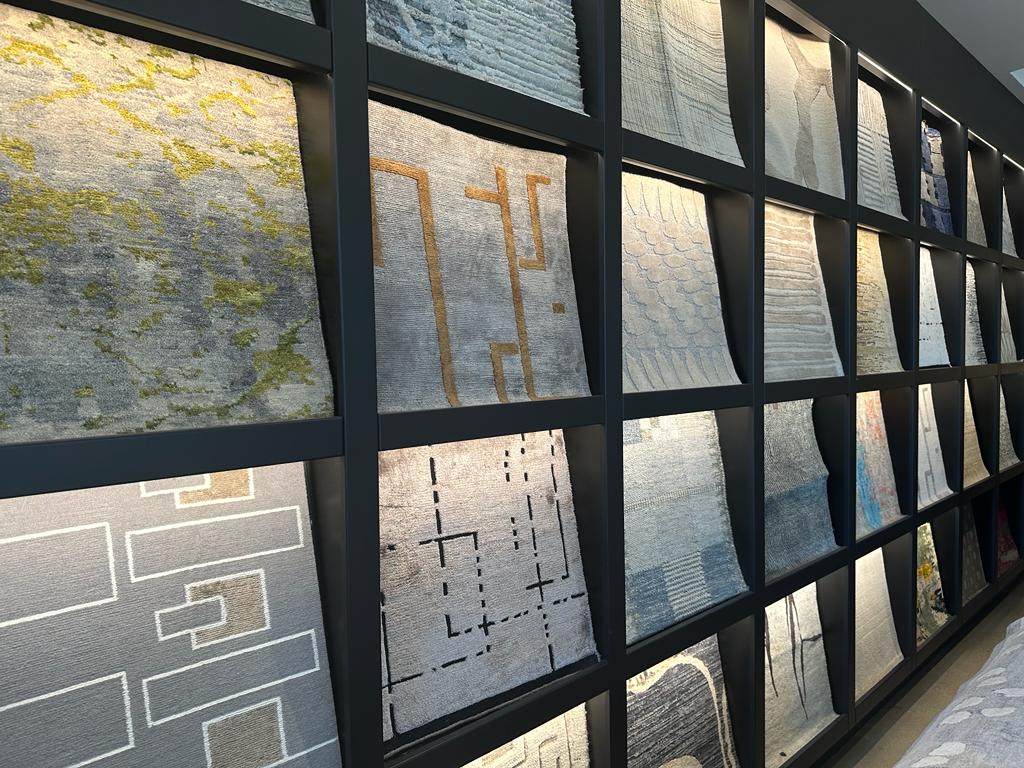
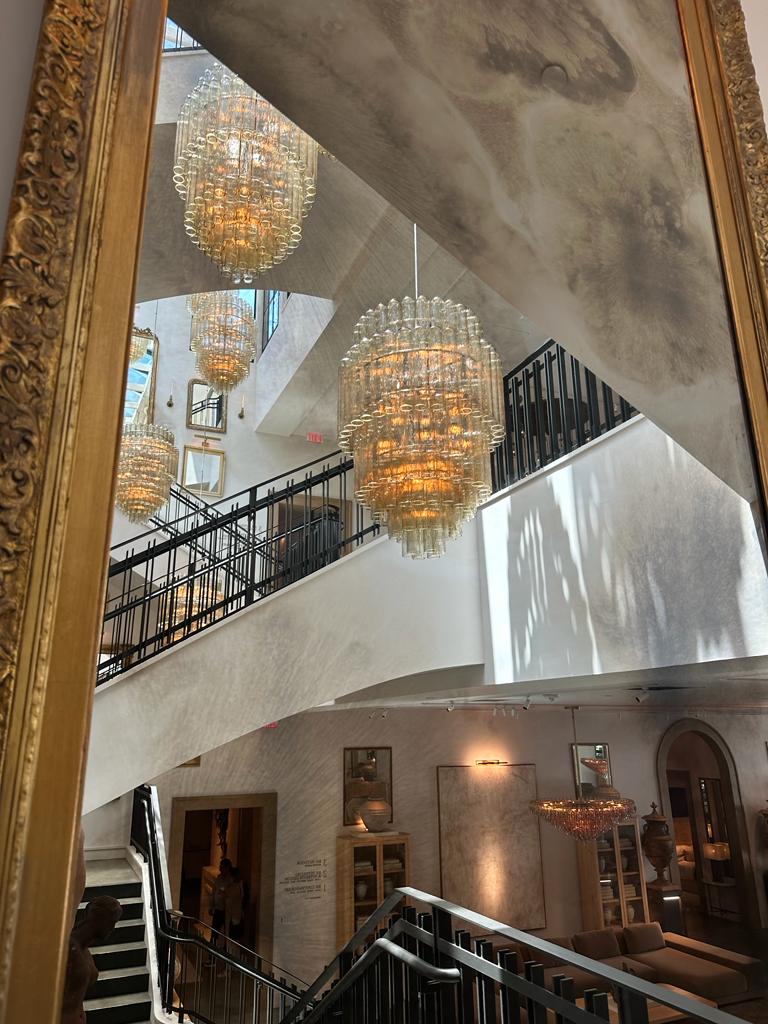
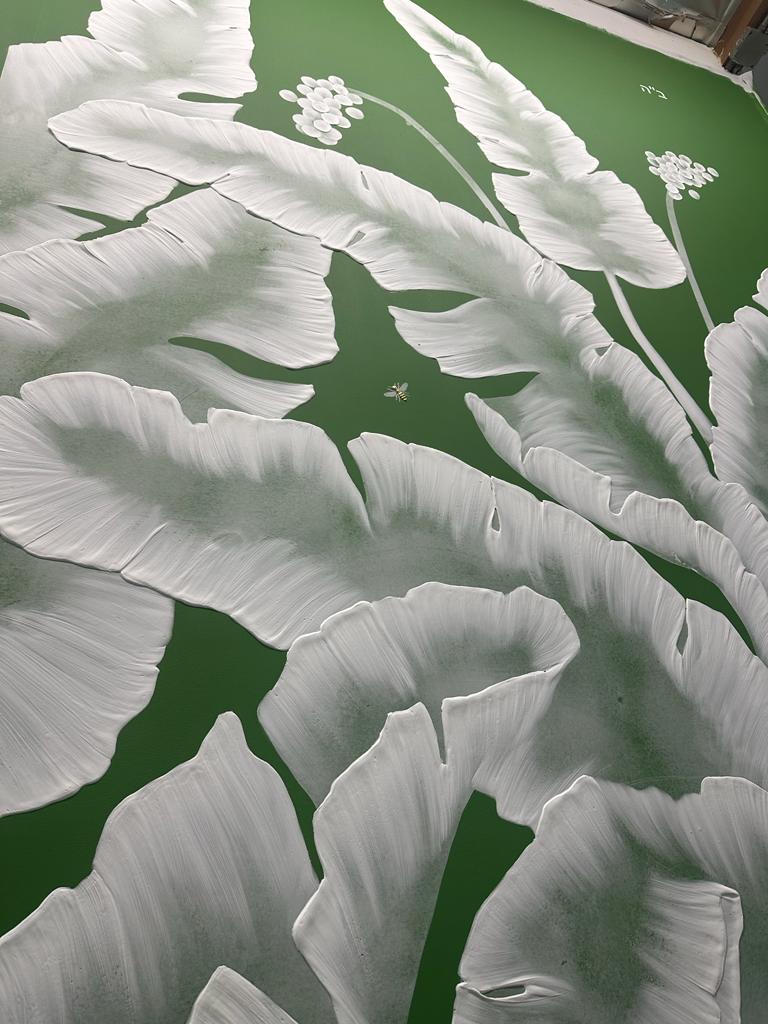
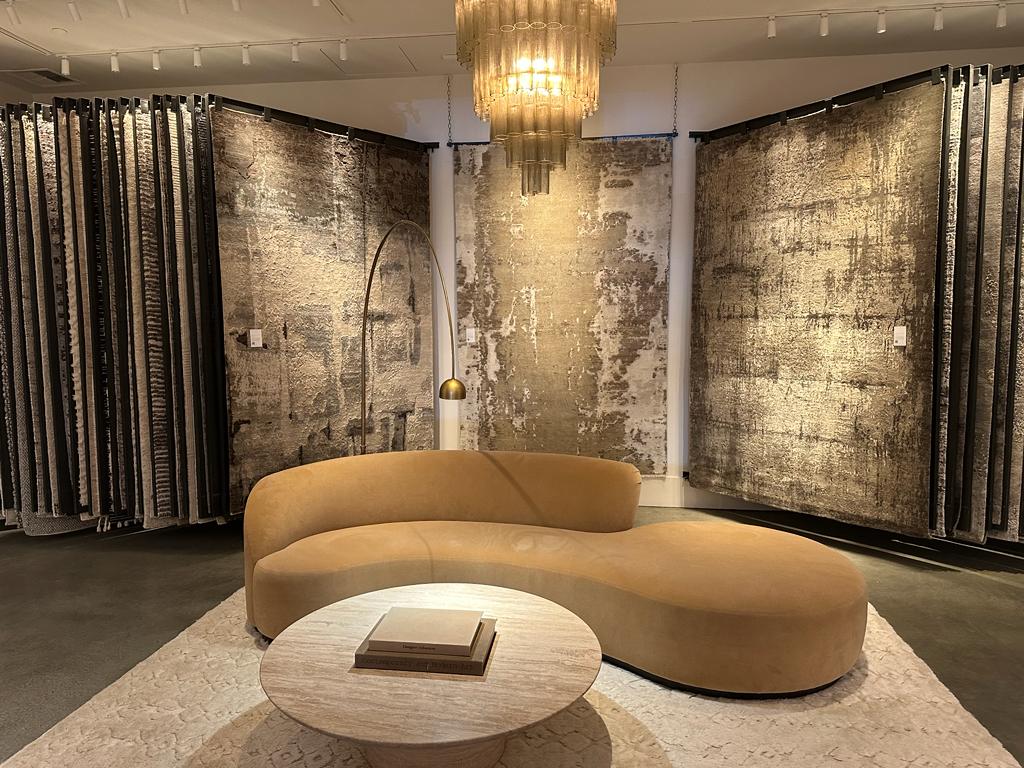
If you’re living in Cailfornia and are looking to make a transformational change to your home and lifestyle, get in touch with us at info@callenderhoworth.com















Côte d'Azur • London • Los Angeles • New York • Paris
Top Nine Outstanding & Unique Bathroom Products for 2023
Enhancing your bathroom’s appeal with a touch of finesse requires a thoughtful approach. Just as we aim to add a sense of distinction to your private retreat, drawing inspiration from the peak of luxurious interior design trends is a smart move.
At Callender Howorth, where excellence seamlessly blends with creativity, we carefully curate our offerings in collaboration with leading figures in the interior decoration industry. From clever concepts for small bathroom spaces to lavish designs, our expertise transforms each area into a personalised haven of comfort and style. Here, practicality effortlessly merges with elegance, creating spaces that are both inviting and sophisticated. Here is what designers have on the radar for 2023 for the latest luxury interior design trends.
1. Vessel Hammock Bath – Splinterworks
What’s the superior route to unwind: reclining in a hammock or indulging in a leisurely soak in a bathtub? The ingenious minds at Splinter Works found inspiration to create a masterpiece that seamlessly blends the two.
Crafted for wet room use, Vessel elegantly hangs from the walls, floating above the floor. Its ingenious design allows wastewater to gracefully cascade through the base into a floor drain.
Constructed from carbon fiber, a material acclaimed for its robustness and flexibility in shaping intricate curves, Vessel maintains an incredibly lightweight composition.
2. The Phone Box – West One Bathrooms
Conceived as an exceptional project, this bespoke creation was envisioned to transform a genuine piece of London’s history into a unique shower experience. The masterpiece is meticulously fashioned from an original K6 phone box kiosk.
Illuminated by a custom LED-lit transom top panel, its hinged door is adorned with extended leather straps for easy access. The unit, reframed with laminate glazing, boasts integrated extraction and pre-plumbing.
A Bossini ceiling-mounted shower, graced with chromotherapy lighting, takes centre stage, complemented by a Waterworks polished Nickel thermostatic control.
This inspirational bathroom design features a wet room-style tray with grid waste, embraced by sumptuous porcelain-tiled walls.
3. Rose Brassware – THG Paris

Since 1878, Daum has crafted exceptional crystal pieces employing rare, time-honoured methods. Each Daum crystal inlay is meticulously handcrafted within their French workshops.
The ‘Rose’ collection, versatile for sink, shower, and bath fixtures, is accompanied by a range of coordinating accessories.
This line offers an extensive array of finishes, including chrome, gold, luxbrass, nickel, and rhodium silver.
4. Lux Shape Steel Bath – Bette
Merge your acrylic bath or washstand with a sleek frame, infusing your bathroom hardware with vibrant accents. The robust steel/enamel composition empowers a minimalist approach – a simple cubic frame serves as the supporting foundation for both fixtures.
Immaculately aligned, the new bath and washstand seamlessly integrate with the frame, while the bath’s inventive technology discreetly conceals any visible overflow.
5. Brassware Special Finishes
2023 anticipates a heightened desire for unique speciality brassware finishes, veering away from conventional chrome. Prominent manufacturers like Hansgrohe have made a significant impact showcasing an impressive array of special order finishes to their product ranges.
The focus lies on brushed gold, bronze, black, and polished copper, imbuing designs with an air of exclusivity.
6. Colour Schemes & Tiles
When beige toilet tiles design loses its charm, and white feels too stark and clinical, a touch of grey might be the remedy. Far from mundane, it brings forth depth and texture.
In 2014, the National Kitchen and Bath Association noted its rapid rise in popularity for bathrooms, a trend resurging in 2023 and poised to maintain its status well into 2024.
Concrete and wood-inspired porcelain bath tiles maintain their contemporary allure for a modern bathroom layout design, projecting a current aesthetic that is set to persist throughout the coming year and beyond.
7. Intelligent Showering Solutions – Ambiance Tuning Technique
Step into a fresh showering realm, where the innovative AMBIANCE TUNING TECHNIQUE, anchored by the central Etool, orchestrates an array of spray types with exquisite ease. This fusion of functional convenience, avant-garde controls, and sleek design, redefines the art of showering.
The three scenarios, BALANCING, ENERGIZING and DE-STRESSING, act energetically on the human dimensions of the body, mind and soul. Each of these scenarios deals with the power of water in such a distinctive way that you can influence your own well-being. By using the scenarios regularly, they become part of a personal ritual and lend a new quality to your shower experience.
Experience the ATT electronic control panel, a marvel of bath accessories, offered in 2, 3, or 4 button configurations.
8. Silenzio Washbasin – Antonio Lupi
A Corian sink encased and optionally illuminated by LED embodies function and artistry, setting a new bar for unique bathrooms. Its sculptural form seamlessly melds into the wall, becoming one with the surface it graces. The washbasin’s subtle presence resembles a blank canvas, awaiting various finishes that can be effortlessly interchanged, offering a swift refresh and transformation.
9. Per Se Brassware – Kallista
The Per Se collection introduced a few years back, has received a captivating enhancement this year through its exquisite new inlay handles. This mixer exemplifies a refined, contemporary minimalism – an embodiment of its very name.
With an inherently graceful foundation and thoughtfully composed details, Per Se exudes an inviting allure. Its unadorned design defies conventions, presenting a sleekness that sets it apart, mirroring the uniqueness suggested by its name.
Per Se offers a choice between plain or inlay handles, including Calcedonia Azul, Mother of Pearl, Tiger Eye, Lapis Lazuli, Malachite, or Black Crystal, for an ensuite bathroom design.
Elevate Your Bathroom with Callender Howorth
Elevate your living spaces to new heights of unparalleled sophistication and indulge in the art of refined living through the visionary designs of Callender Howorth. As a premier luxury design studio based in the heart of London, we specialise in crafting bespoke architectural and luxury interior design masterpieces that redefine the concept of elegance.
Explore our latest luxury interior design projects for more inspiration.















Côte d'Azur • London • Los Angeles • New York • Paris
Summer Garden on the Cote d’Azur
The hot days of summer are sizzling away and we are looking for those cool shady areas to lounge and relax. The feeling of being in a beautiful garden beckons us with its freshness and natural delight.
No matter how big or small, a well-designed garden is an extension of your home where you can just sit back and relax, tend your garden, or entertain.
So who better to share a garden creation story? None other than Mark Howorth, the creative director of Callender Howorth Interior & Architectural Design.
Mark’s personal garden design story.
“Whilst renovating my new home on the Cote D’Azur I had to think about the garden and the land, and how I best wanted to style and design this area. As one lives outside most of the time in the south of France I wanted to create a calm and relaxed space with plenty of seating areas to chill with friends, read books, and simply enjoy the al fresco lifestyle.

My house was built in 1840 and is a lovely old stone house. I wanted the garden to feel very Provencal and look like it had been in place for years. Lots of native plants and scents as well as a non-structured approach. The garden would be very organic and rambling to create a gentle and eclectic mix of nature.
I sourced old stone to create specific seating areas that one discovers as one walks through the property with little surprises like a fish pond surrounded by pine trees.
On the plants, I wanted to have native plants and ideally plants that were more drought resistant.
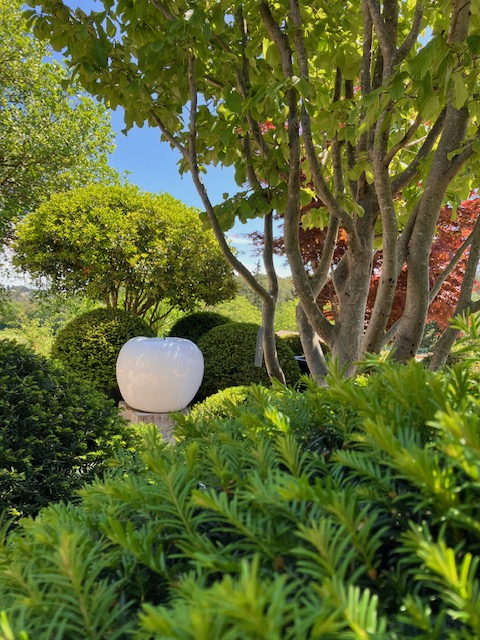
Photo courtesy English Garden Center.
I visited the English Garden Center in Opio many times and they were incredibly helpful in showing me many plants that would create my Provencal-type garden, such as lavenders, rosemary, thyme and Mediterranean varieties such as – Eucalyptus Rostrata, Laurus Nobiis bushes, Verbena Bonariensis and Lavandula Dentata.

Loberon.fr
I used a melange of furniture and styling items to give the garden character and make it not look too much like a catalog of furniture companies! One excellent company was Loberon.fr for sourcing all furnishings for the garden – I particularly liked the candle holders that are dotted around the garden.
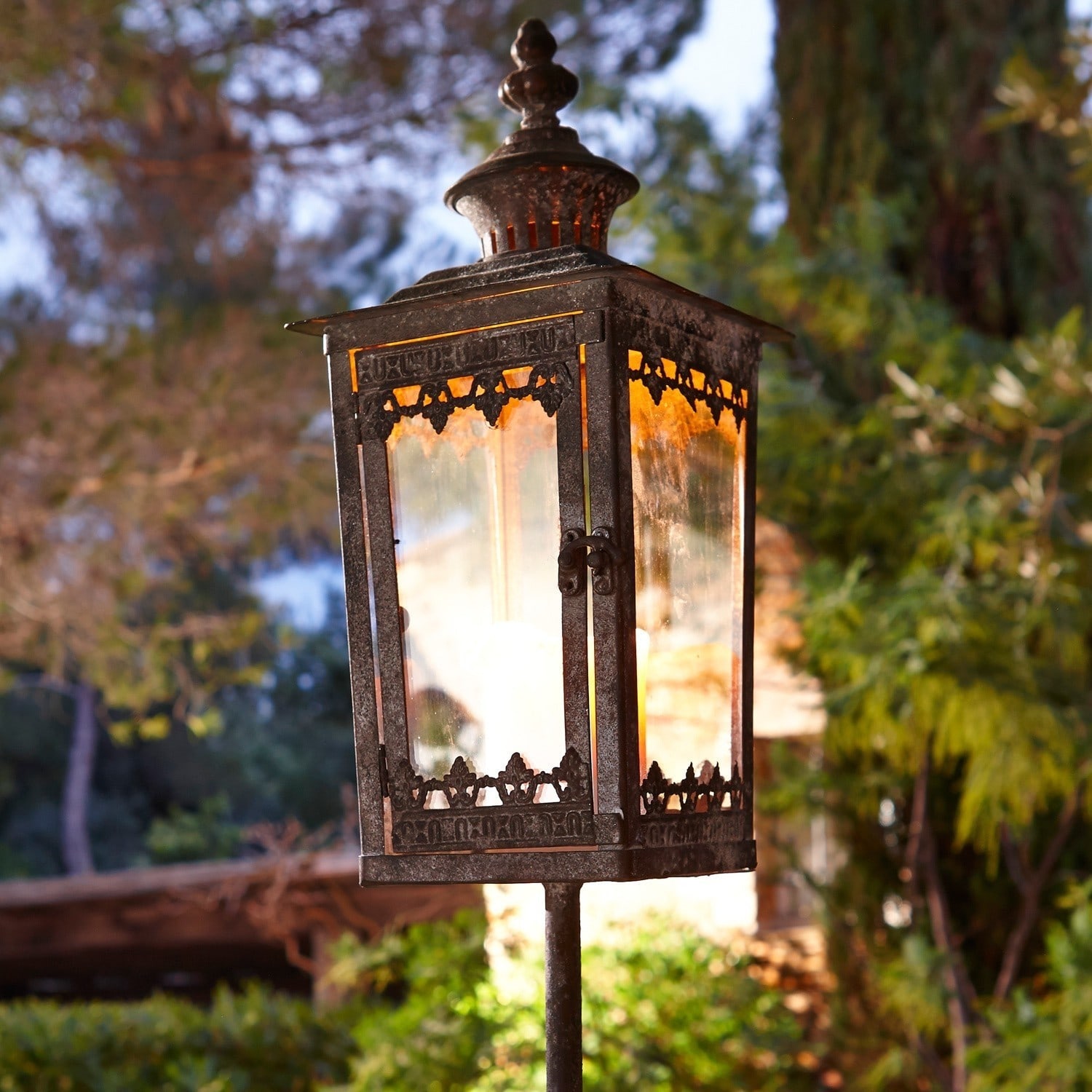
Lantern Nielas by Loberon.fr.
Lighting is very important and I wanted the right style of lights to fit with the character of the house. I found these wonderful lanterns from Roger Pradier.

Rogier Pradier, Place de Vosges 1
Roses are my absolute favourite and I wanted to plant a significant amount at the house. A great place called Les Rosiers de Mougins has a phenomenal selection of roses that have been cultivated and developed by the same family for over 3 generations.
The varieties are incredible and are developed to work in the heat and give the maximum scent. They remind me of the stunning old roses my grandmother had in her garden for years. They also have been developed to flower 3 times a year – so for me, this was perfect and have planted 40 bushes in the land that give me so much pleasure.

Working on the external design really is the same as interior design but with plants! It’s about creating areas to relax and making the space feel inviting and stylish.
Now that all is done and I am in the house – the garden gives me so much pleasure – to walk around early in the morning at 6 am when all is calm and the light is magical – checking the plants and watching the dragonflies hover above the pond, and the swallows gracefully swoop over the house really is pleasure and privilege!”
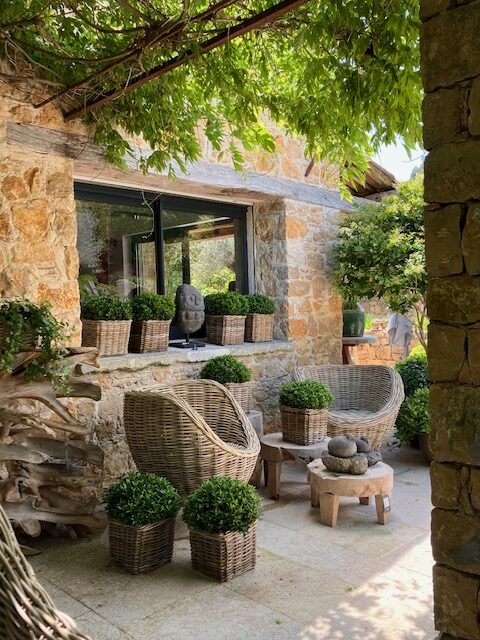
Photo courtesy English Garden Center
Here are 5 essential steps to creating your summer garden:
Define the purpose of your garden.
How do you want your garden to serve you? Do you want it as a chic outdoor space to entertain or an idyllic niched haven to unwind with a book or a place to grow your vegetables?
Take a good look at your space. Take note of the size, the natural sun exposure, and any natural features such as existing trees or structures or the vis-a-vis from your neighbour.
Identify the type of maintenance plan for your garden. Do you want a garden with minimal care or a hands-on garden where you are actively participating in its daily care? You want to be keenly aware of your local climate to know which types of plants and flowers are best suited for it.
Allergies?
If you or your family has allergies, you can check with your local greenhouse to see if the types of plants, flowers, and shrubs are allergy friendly.
Furniture and decor.
How do you want to sit or lounge outside? What type of experience do you want to have, relaxing or formal? Lounge style with day beds or more traditional? For larger homes, you might want a big open space with longer sofas and armchairs for entertaining, or smaller niche areas for a specific use, such as a quiet nestled area with a daybed surrounded by flowers and shrubs. Is there a pool? Would you like a lounge or dining area by the pool? Perhaps upgrading to a pool house? Since the pool is a focal point of your garden, be sure to include it in your preliminary brief.
Lighting matters!
The lighting design plan should be considered in this step. Things like solar-powered flood lights or decorative lanterns are a part of the furniture design scheme. Gardens are just as if not more beautiful at night, so the lighting, as with interior design, is a key element.
Professional consultation
The last step in designing your summer garden is taking you preliminary brief and working with an interior/exterior designer and/or a landscaping company to develop the final design. They can give you several design options based on the types of plants you like and the maintenance plan required as well as climate considerations.
Callender Howorth works with the English Garden Company for our projects on the French Riviera. Together with their landscape architects, we design an integral plan that reflects the beauty and personality of your home that connects the interior with the exterior.
By working with a professional design and landscaping company, they will be able to show you a concept design of your garden so that you can be sure it will be your idyllic haven. Remember that your exterior areas are an extension of the interior design of your home. So a proper design takes into consideration all areas of the home.
A summer of enchantment awaits you in your new garden!
For any questions or additional information, the team of designers at Callender Howorth is delighted to help you with your next project. Contact us at info@callenderhoworth.com















Côte d'Azur • London • Los Angeles • New York • Paris
Spring into style at home
Let spring set the stage for a new change.
Spring has arrived and like every year, we find ourselves taking in a welcoming sigh to warmer weather, flowers blooming and the new fresh new energy that blooms in springtime.
Yet when we look around our home, we can feel the lingering remnants of a long cold winter which are not exactly flowing with our new inspiring breaths of spring.
Historically and religiously, spring has been attributed to a period of transformation, renewal, and new beginnings. As the buds start to pop with fresh and bright colours, so does the symbolism of starting fresh and starting over.
This is the ideal time to take stock not only of our inner environment but also our outer environments starting with our home. Hence the idea of spring cleaning pops into our mind and rightfully so…it’s time to move things out to make room for life’s joys to move in.
Here are a few ideas to help you welcome in the spring with style in your home for a fresh start!
Start with decluttering
If decluttering seems to be a daunting task, consider it this way. You are clearing out the chaos.
Lack of storage, the colours in your home that were once bright and are now drab, all the extra stuff that your spouse has filled up the house with, all the things that your kids have trouble with keeping tidy, and the same furnishings you have kept for the last 10 years, as well as your overstuffed closets with items that you haven’t worn in years. These are all things that create a stuck feeling in your home and in your head.
If you are looking to sell or rent your home, this is the first order of business your agent will tell you.
The dramatic difference wall colour makes
One of the fastest ways to bring new energy into your home is through colour. Look at the colours on your walls. Are the walls dirty or faded? Remove a piece of furniture from the wall and you will see if it is.
Colour directly affects our moods. They can affect our emotions and state of mind. They can also directly affect the amount of natural light you have in your home by how much light the colours absorb and reflect the light.

Callender Howorth residential High Gate house project.
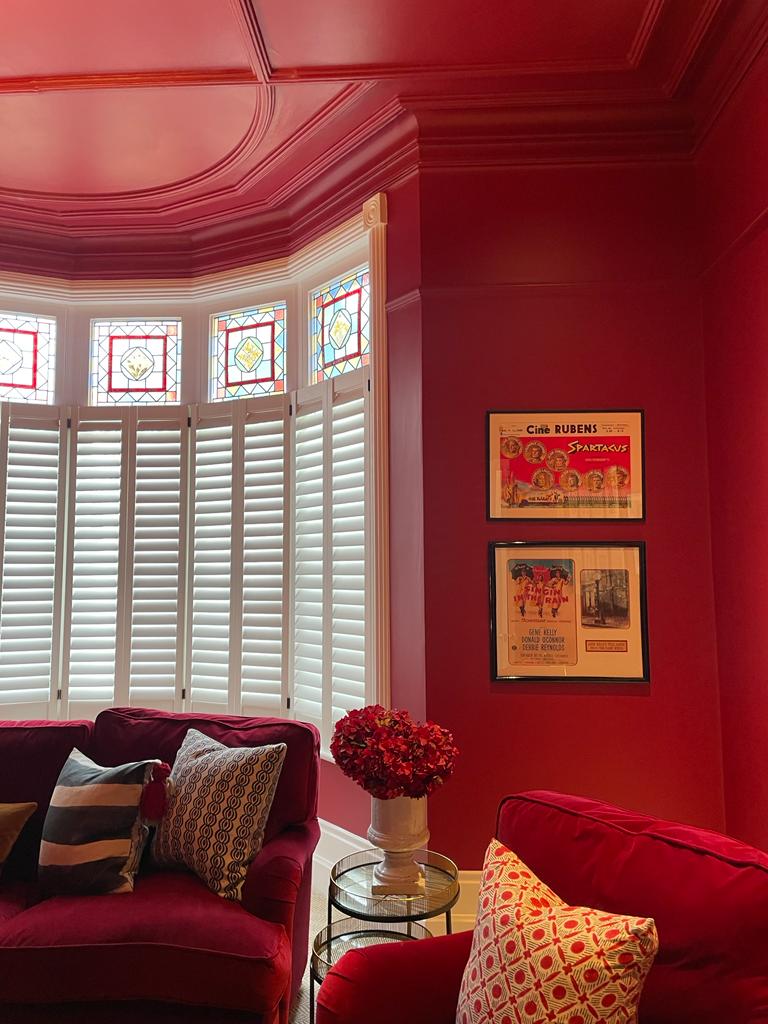
Callender Howorth estate project in Twickenham, UK.
Before you pick a paint colour, Benjamin Moore has a wonderful app have an app where you can photograph your room and drag your paint colours onto the wall and it populates the colours for you. It’s brilliant and a really clever way to see the difference a new wall colour will have in your space.
Upgrade your walls with new wallpaper and wall coverings.
If you are inspired to upgrade your walls to another level, then it’s worth taking a look at all the beautiful collections of wallpaper available now. Gone are the days of the outdated wallpaper from the 1970s and 80s!
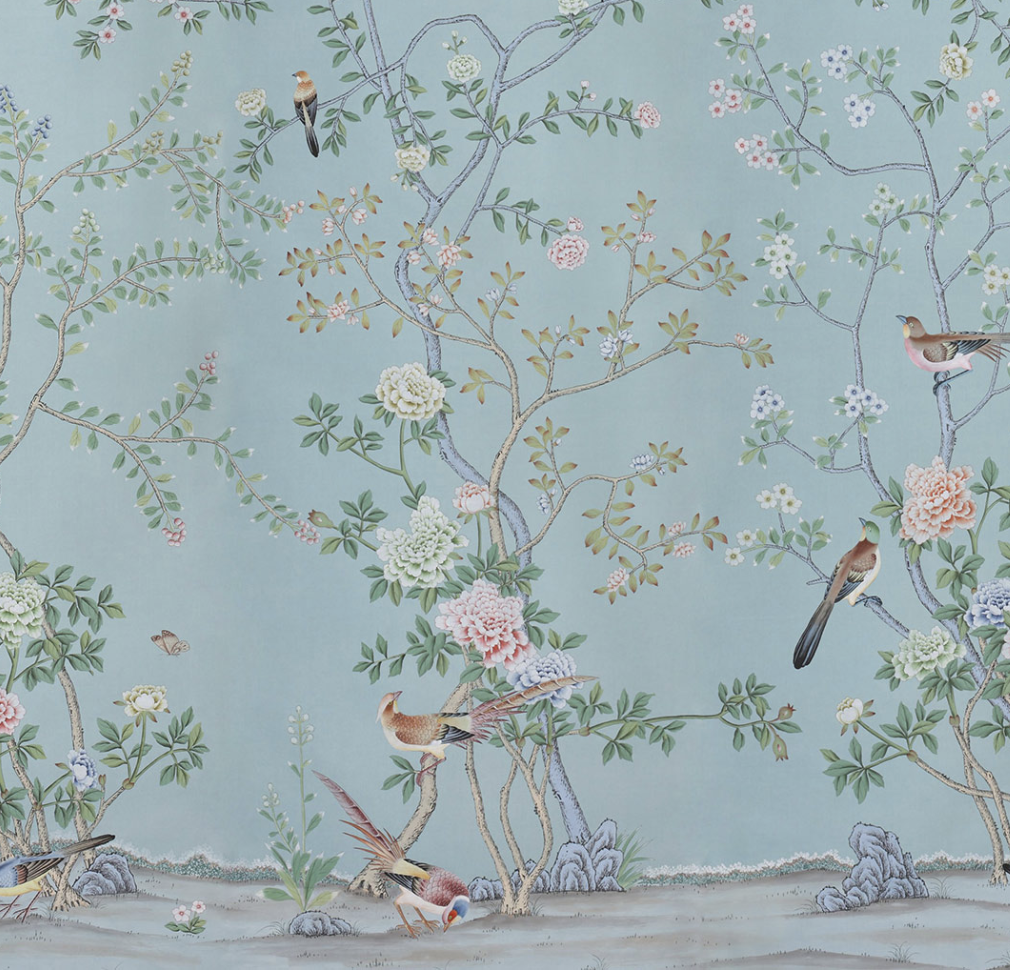
deGournay’s Chinioiserie Collection Earlham Standard Colourway.
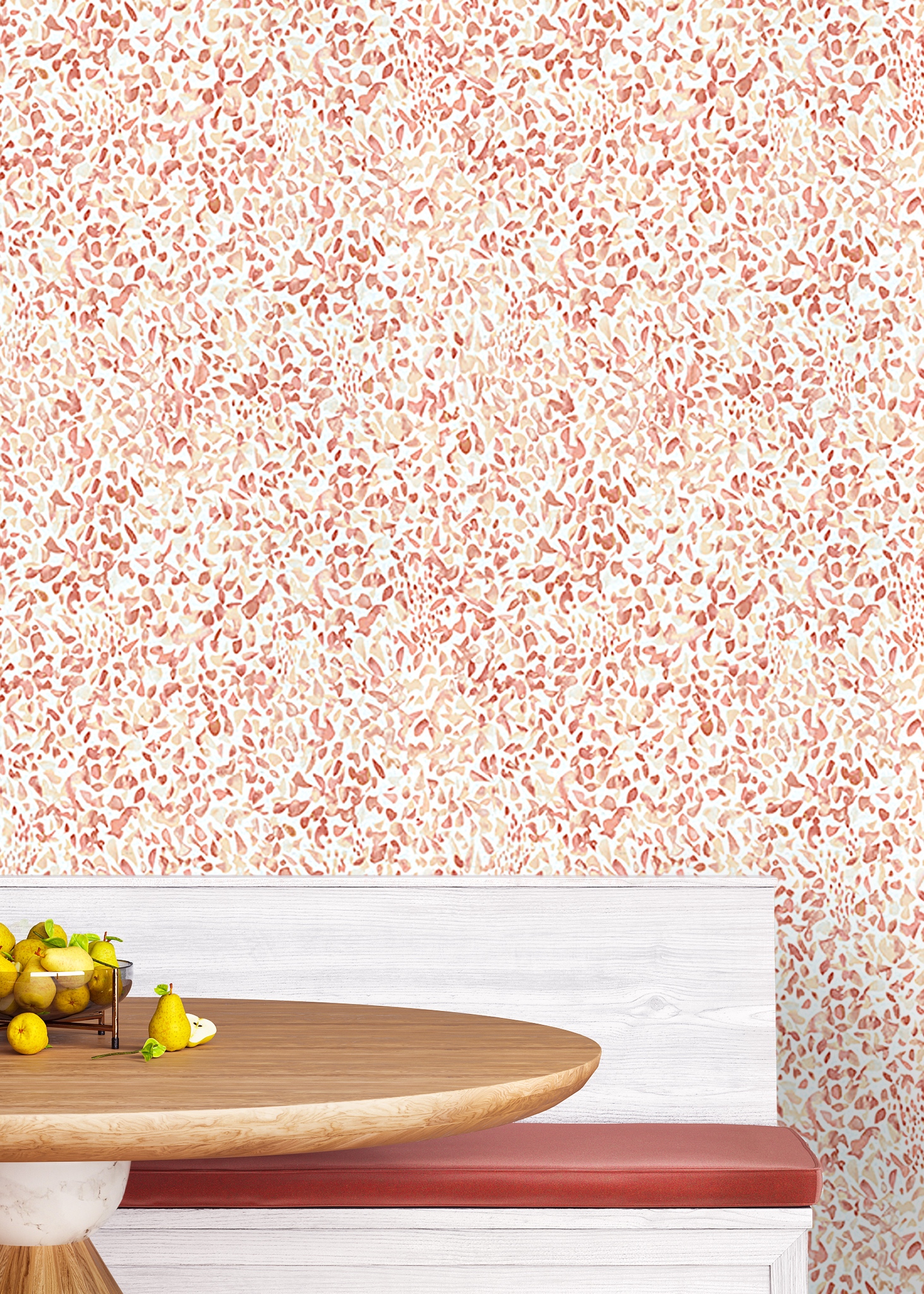
Pretty Petals by Phillip Jeffries.
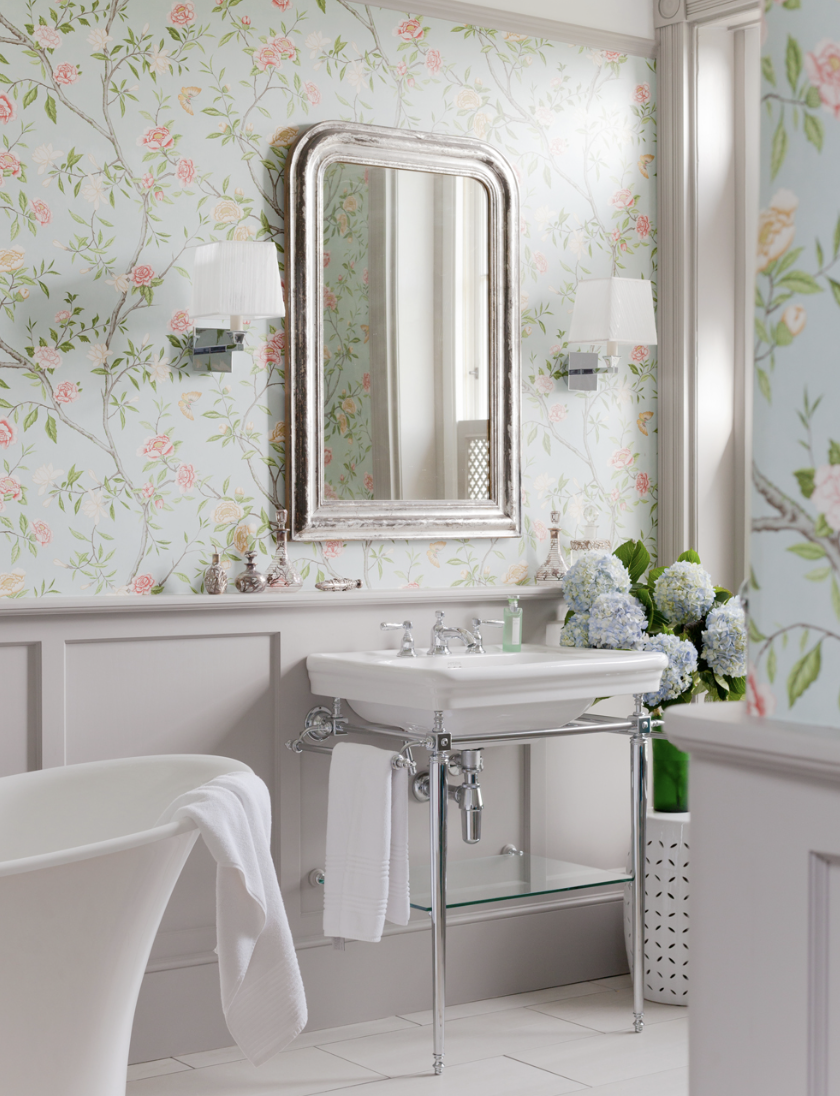
Callender Howorth residential Country House project.
Some of the hand-painted designs and print designs are exceptional as well as innovative with many new textures, selection of materials, natural and even recycled wall coverings to choose from.
Philip Jeffries Manilla Hemp are handcrafted and use only sustainable materials.
Lighting, lighting, lighting
One of the pillars of interior design is the lighting.
Capturing the natural light, mood lighting, direct and indirect lighting, all play an integral role of the mood, look and feel of your home.


In our Aspen House project the Callender Howorth team worked with Rothschild & Bikers to create a custom pendant chandelier.
Pendants and chandeliers naturally draw your eye in their luminosity, brilliance and style. They can instantly elevate a room to a luxurious space taking it from simple to sassy!
Decorative table lamps are wonderful ways to add lighting as well as splashes of colours to the room.
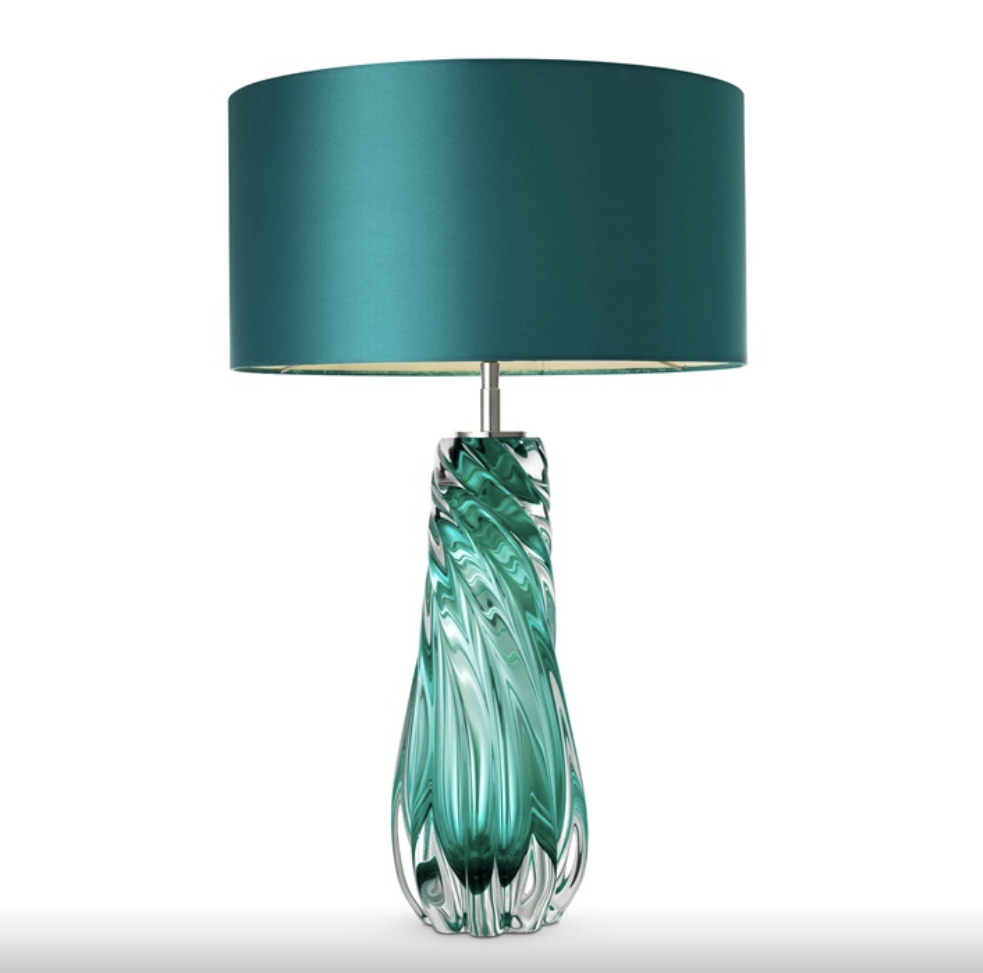
Barron table lamp by Eichholtz.
We spend a lot of time for our clients getting the lighting just right because it is the thread that ties everything together.
Customise and revitalise
A great way to renew one of your favourite armchairs, benches, headboards, dining chairs or sofas is by customising your furniture pieces. Whether it’s a new piece or a vintage piece, you can create a style that is unique to you.
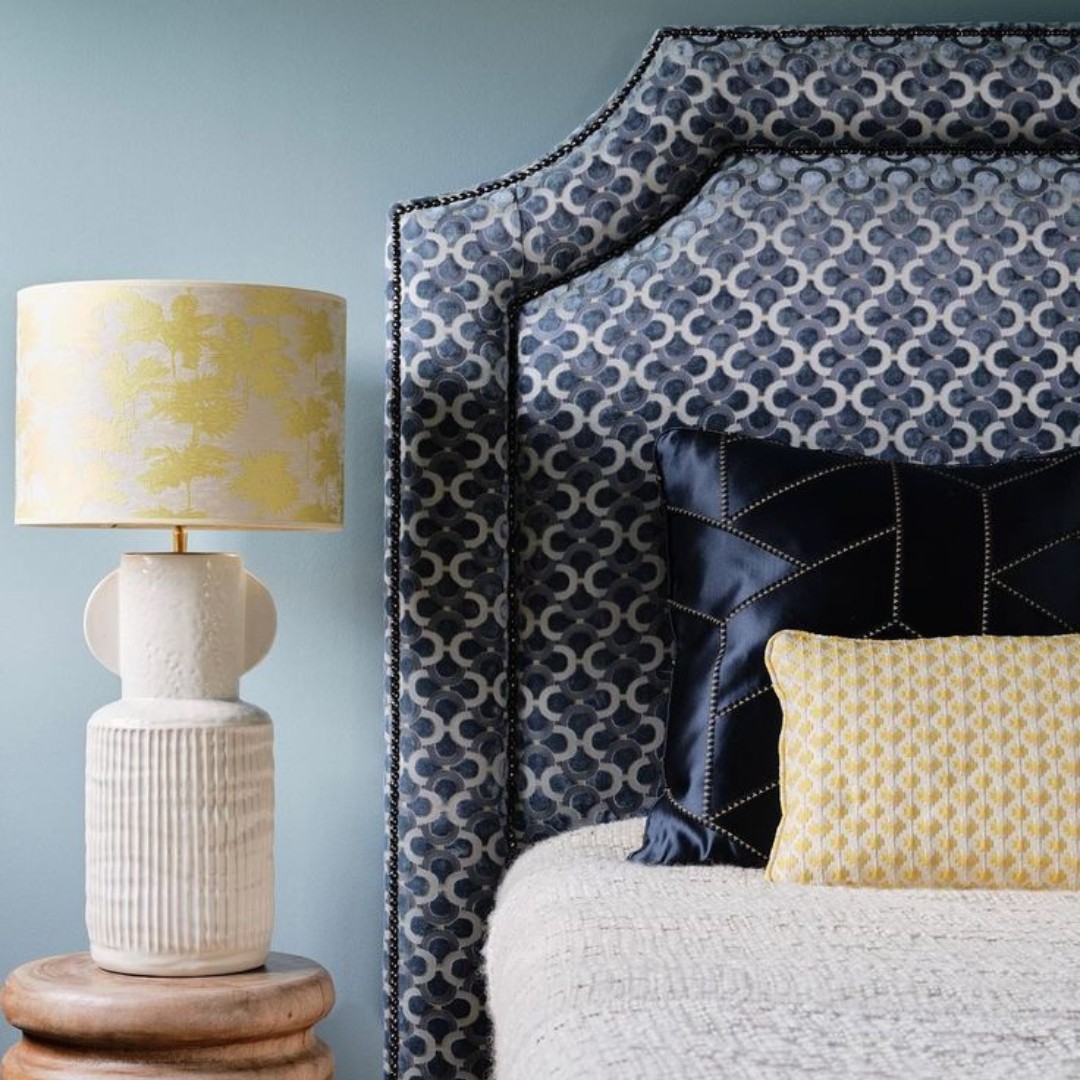
Fabrics by Dedar Milano.
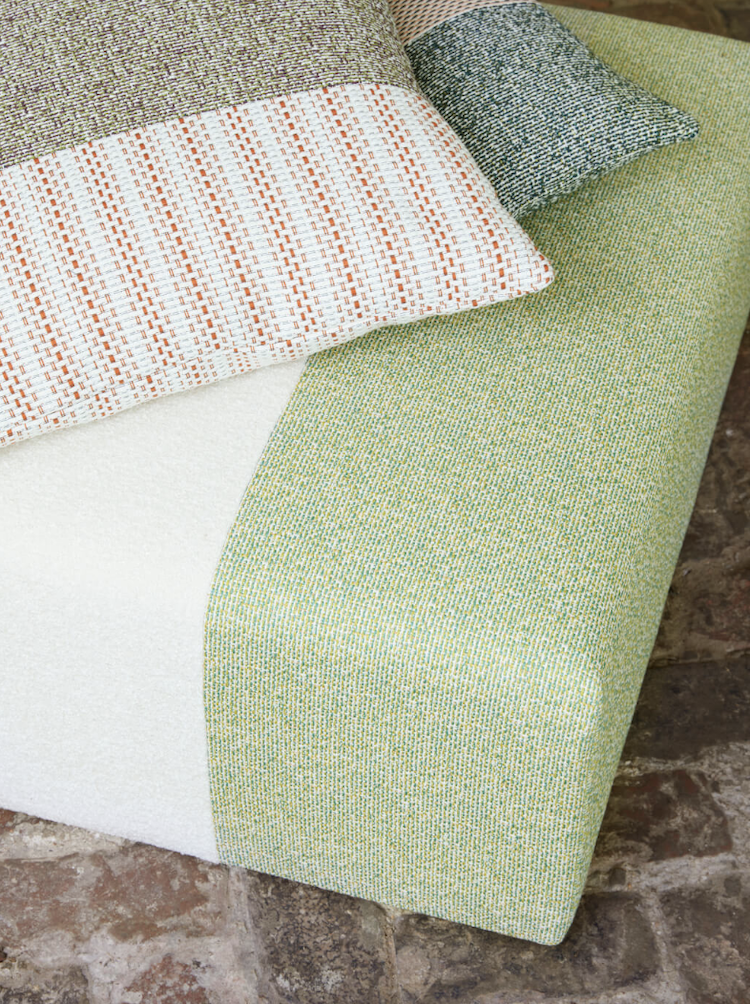
Pierre Frey fabrics.
There are so many fabulous fabrics to choose from and you can play with textures and colours to create the perfect accent piece or focal point in your space.
A couple of our favourites are Italian Dedar Milano and French fabric supplier Pierre Frey whose fabrics and textiles can turn any furniture piece into a stunning showstopper. By customising your furniture, your signature personality comes through in the ambiance in the room.
Total transformation….a complete fresh start
If you are looking a complete fresh start, we recommend a total home transformation. It’s more than just interior design. It’s a life change.
We spend a considerable about of time getting to know our clients even their children so that the new design truly reflects their needs, lifestyle and desires. Your home should reflect your personality and the way you enjoy living.
After we complete a thorough assessment as well as budget expectations, we sit down with initial concept designs so that our clients can review every aspect of their new home.
If you are looking for a complete change, our team of interior designers and architects are delighted to sit down with you to start the transformation process.
You can email us at info@callenderhoworth.com















Côte d'Azur • London • Los Angeles • New York • Paris
New Year New Home with guest Philip Weiser Carlton Group – My Place Riviera Podcast Ep2
On today’s podcast, we are delighted to be joined by one of the Riviera’s iconic real estate legends Philip Weiser, foudner and CEO of Carlton International Property Consultants who has been selling property here for the last 25 years.
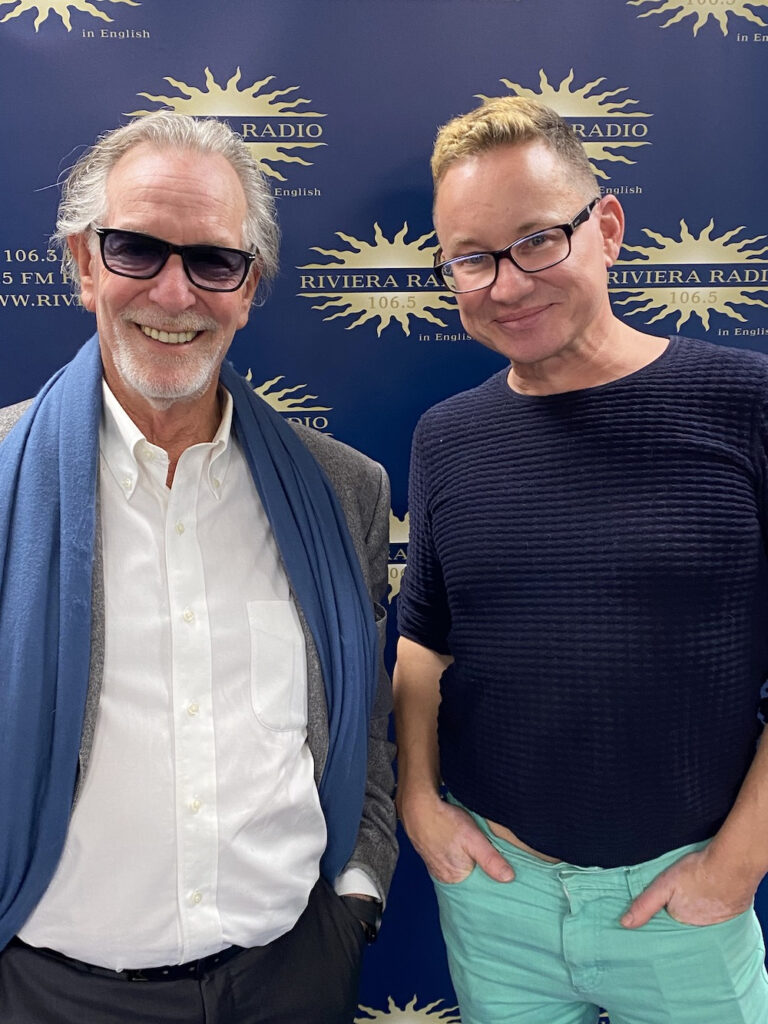
Philip, originally from New Zealand, is a long-time resident of 42 years here on the Cote d’Azur, speaks 4 languages, and is one of our favourite storytellers!
We have the pleasure to work with Phillip and his team at Carlton International on interior design and renovation projects as well as finding properties for our clients.
Listen to Episode 2 here:
Among a stunning portfolio of properties for sale, this waterfront home offered by Carlton International is the former home of Annie Lennox and Dave Stewart of the Eurythmics and is certainly an idyllic location to be inspired by the beauty of the Cote d’Azur!
If you have any questions about the topics discussed in this episode of My Place Riviera, we will be delighted to answer them in our next episode. You can send all your questions to info@callenderhoworth.com.















Côte d'Azur • London • Los Angeles • New York • Paris
Callender Howorth presents the My Place Riviera Podcast with Mark Howorth
Welcome to the My Place Riviera Podcast by Callender Howorth on Monaco’s Riviera Radio 106.5!
Join Mark Howorth and Juanita Viale for a lively chat about everything related to interior design, home renovations, entertaining, lifestyle and top tips for living your best life on the French Riviera and Monaco.
We will be featuring local experts, surprise guests, Mark’s interior design tips, local sourcing secrets, as wll as answering all of your frequently asked questions about building, renovation, decor and styling your home.
You can send all your questions either to info@callenderhoworth.com or info@rivieraradio.mc.
In this first episode of My Place Riviera, Mark will be sharing his journey as an interior designer and his company Callender Howorth, followed by some key tips to prepare your home for this holiday season!
Join us!!
The My Place Riviera Podcast will be on air on 106.5 and 106.3 FM on the 23rd and 25th December 2022 at the following times: 7.55am, 10.55am, 2.55pm, 4.55pm et 5.55pm















Côte d'Azur • London • Los Angeles • New York • Paris
The Wow Factor in Luxury Interior Design
Image above: Primrose Hill penthouse by Callender Howorth.
When you walk into a room and feel taken aback by its beauty and sense of wellbeing, what you are responding to is the mood set by the lighting design.
You can have a room filled with beautiful and luxurious furniture and decor, but if the lighting design is not correct, you will not feel the intended energy and experience of the space. In fact, you will feel like something is off, or that it is missing the wow factor.
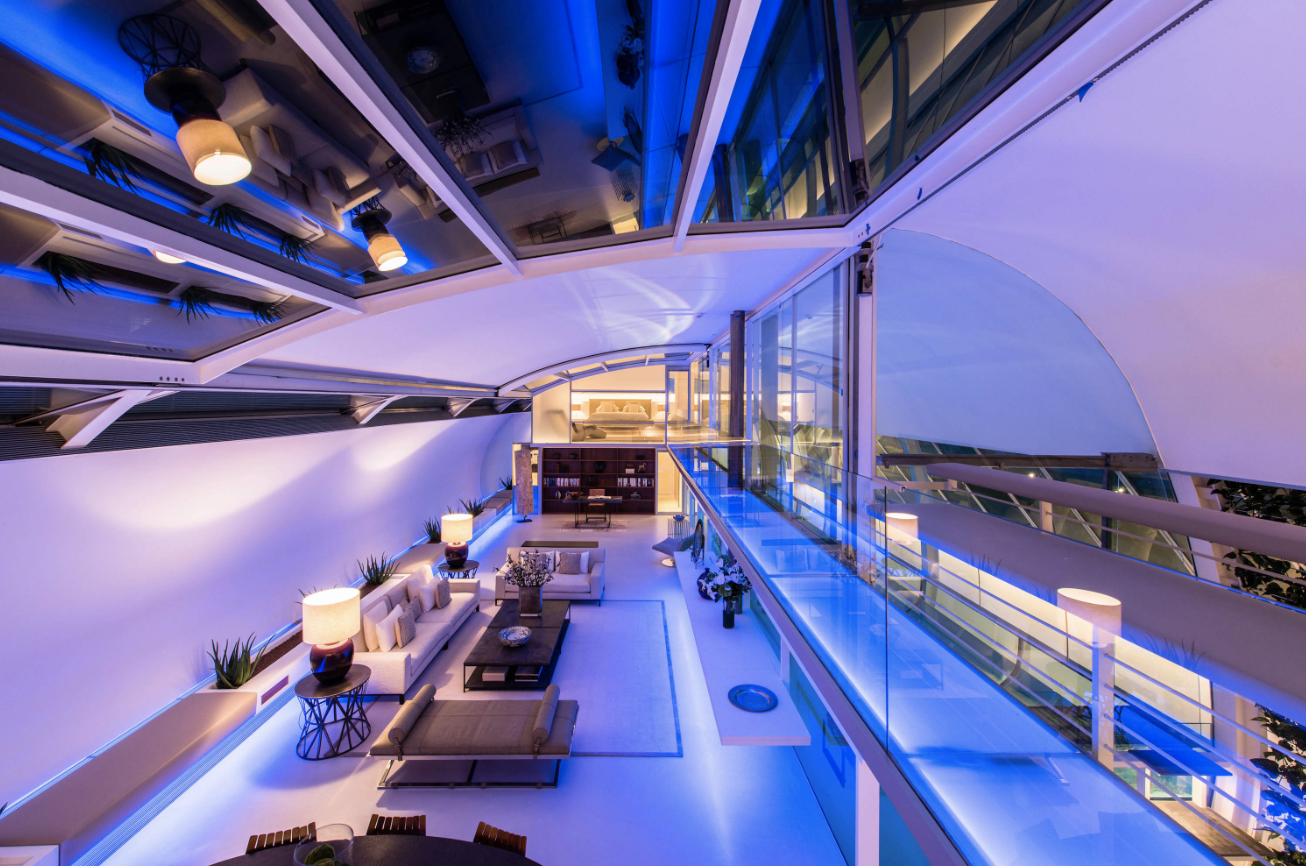
Regents Park House project by Callender Howorth.
As one of the pillars of interior design, lighting directly affects our senses and our mood. Studies have found that the more intense the light, the more intense emotions are perceived to be. Not only does lighting affect our moods, but directly affects our biorhythm and even our circadian rhythms.
Lighting is what makes us feel safe and relaxed at home, and directly affects our productivity at work. It also links the connection between rooms ensuring a smooth transition from one room to the next.
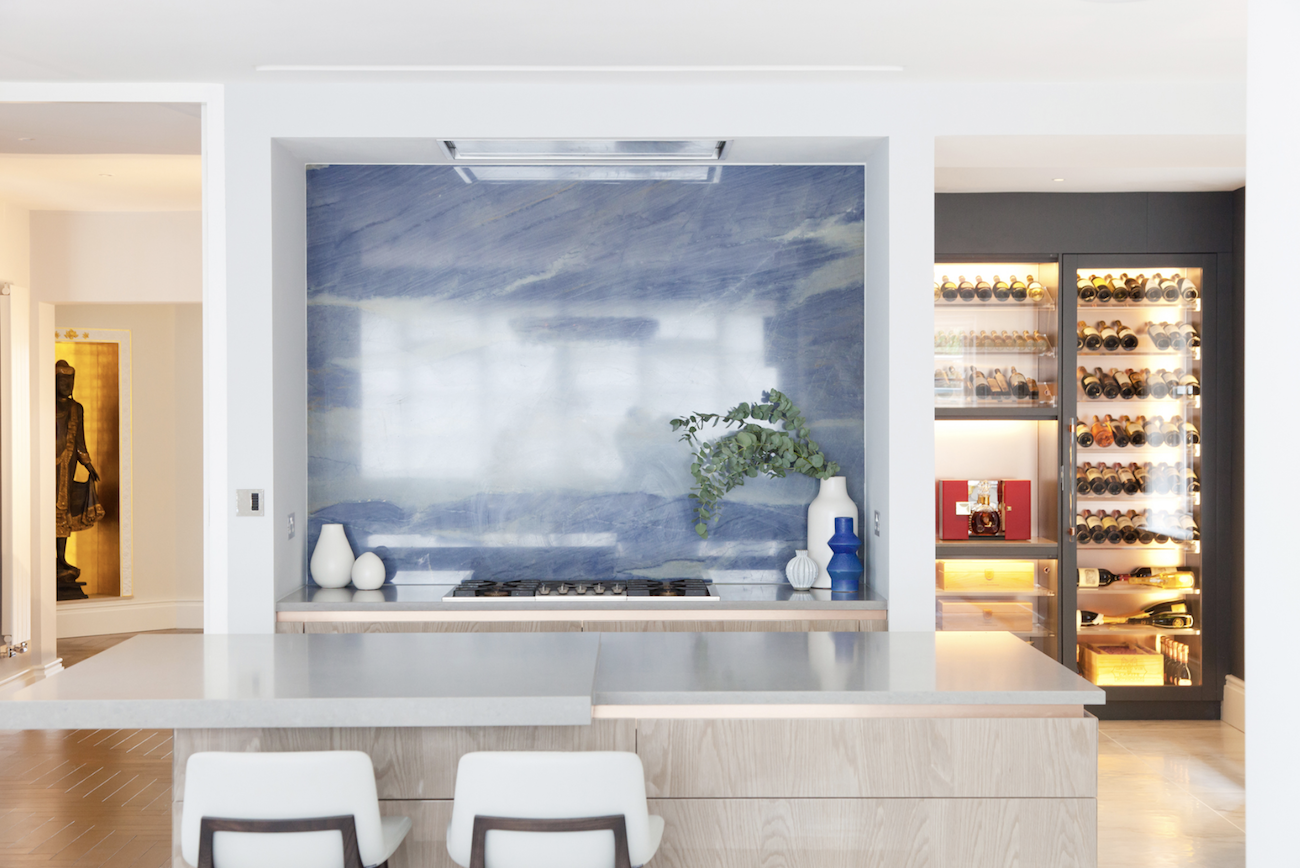
Heath Drive Hampstead project by Callender Howorth.
Callender Howorth managing director Mark Howorth explains, “Lighting design is such an important element of the interior design process. It is one of the key ways that we create the wow factor with our designs. There are many facets to getting the perfect interior design – and our lighting design team is key to getting the big wow factor that our clients want.
Good lighting design adds the magic that lifts and enhances all of our designs to the next dimension. Whether we are looking to create a cosy reading corner or a multi-function space the same principles are adopted to ensure our projects are delivered to the highest level.”
However, lighting design is a uniquely creative and technical process that requires the vision of a skilled team that can translate the overall design to produce subtle colours and intensity bringing the design to life.
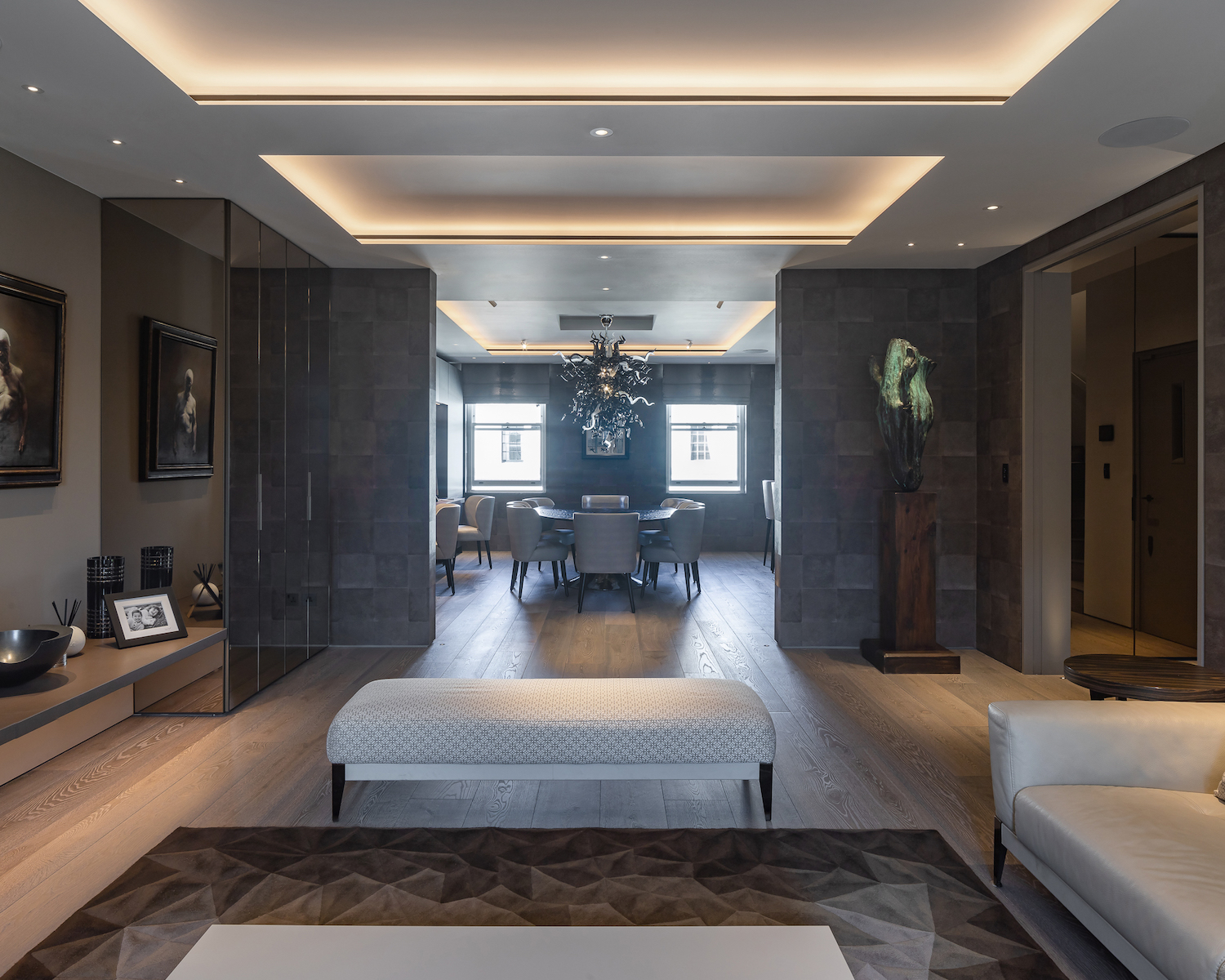
Photo by London Lightworks.
Our team at London Lightworks are masters of creating the perfect balance for our luxury residential projects which require the utmost highest attention to precision and detail.
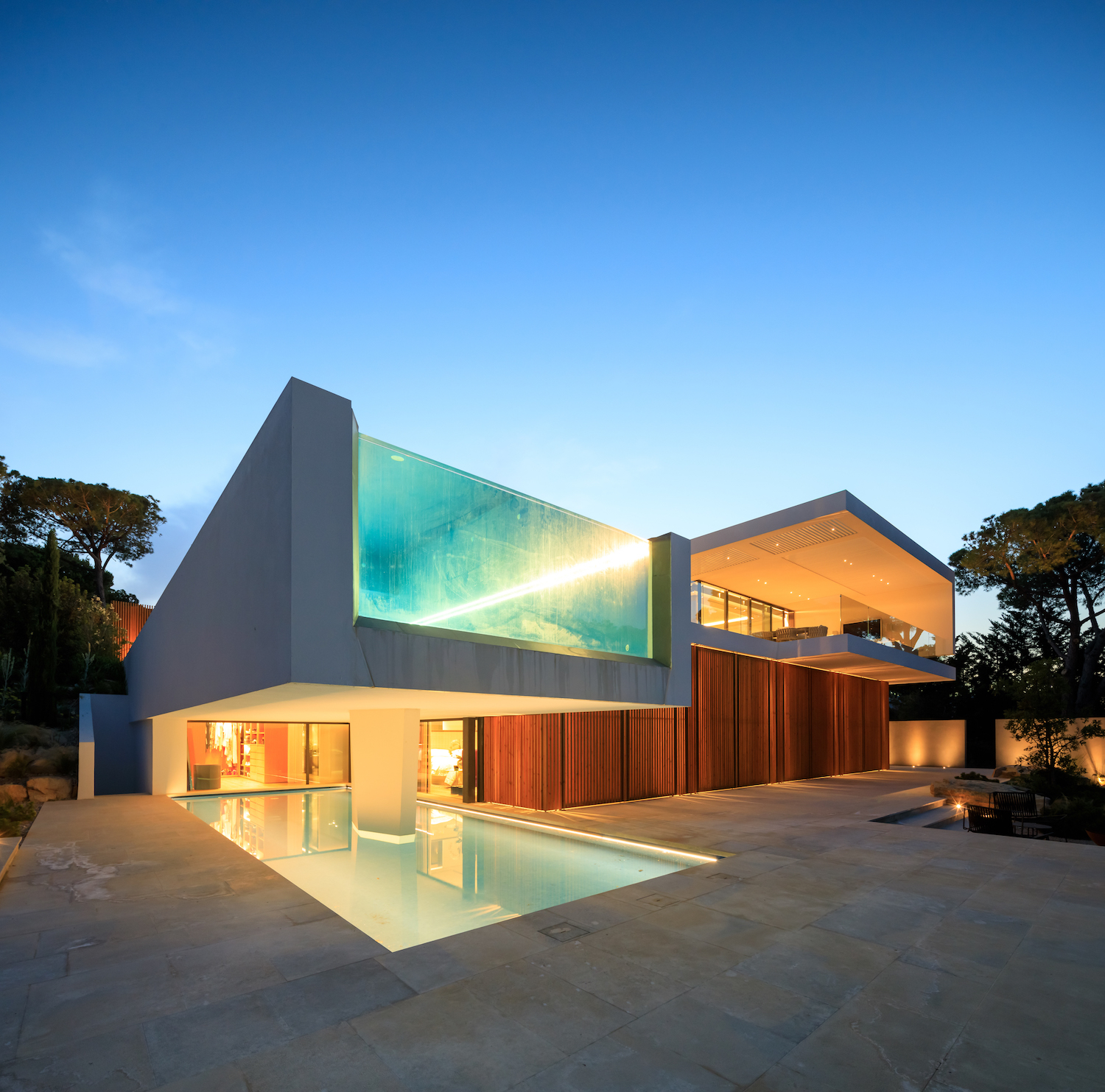
Photo by London Lightworks.
Mark Kazer from London Lightworks shares his intentions behind lighting design. “An expertly designed lighting scheme adds another dimension to your space, bringing an interior design project to life. Great lighting creates depth and height, and cosy spots, and draws attention to your most impressive areas or features of the room.
It’s all about the balance of light and shade and bringing new energy to an interior. Considering a user’s interaction with any given space is so important to how a lighting scene is set to ensure it is comfortable and really portrays the moods we wish to create.”

Country House residential project by Callender Howorth.
Callender Howorth Interior and Architectural Design provides an English-speaking design and build team for luxury interior design projects across the French Riviera, Monaco, London and New York.
If you are looking to renovate your home, we invite you to contact us by email to Mark Howorth at mark@callenderhoworth.com or call +33 483 5805 27.
For press inquiries contact Juanita Viale at juanita@callenderhoworth.com















Côte d'Azur • London • Los Angeles • New York • Paris
Cultural Influences on Design
On a recent sourcing trip to Marrakesh, the beauty of the Moroccan culture vividly speaks to you as you meander through the winding ancient streets of the Medina.
The sun-baked red terracotta facades of the buildings and mosques instantly transport you to their ancient roots and history with the energy of its Berber origins permeating this maze-like imperial city.
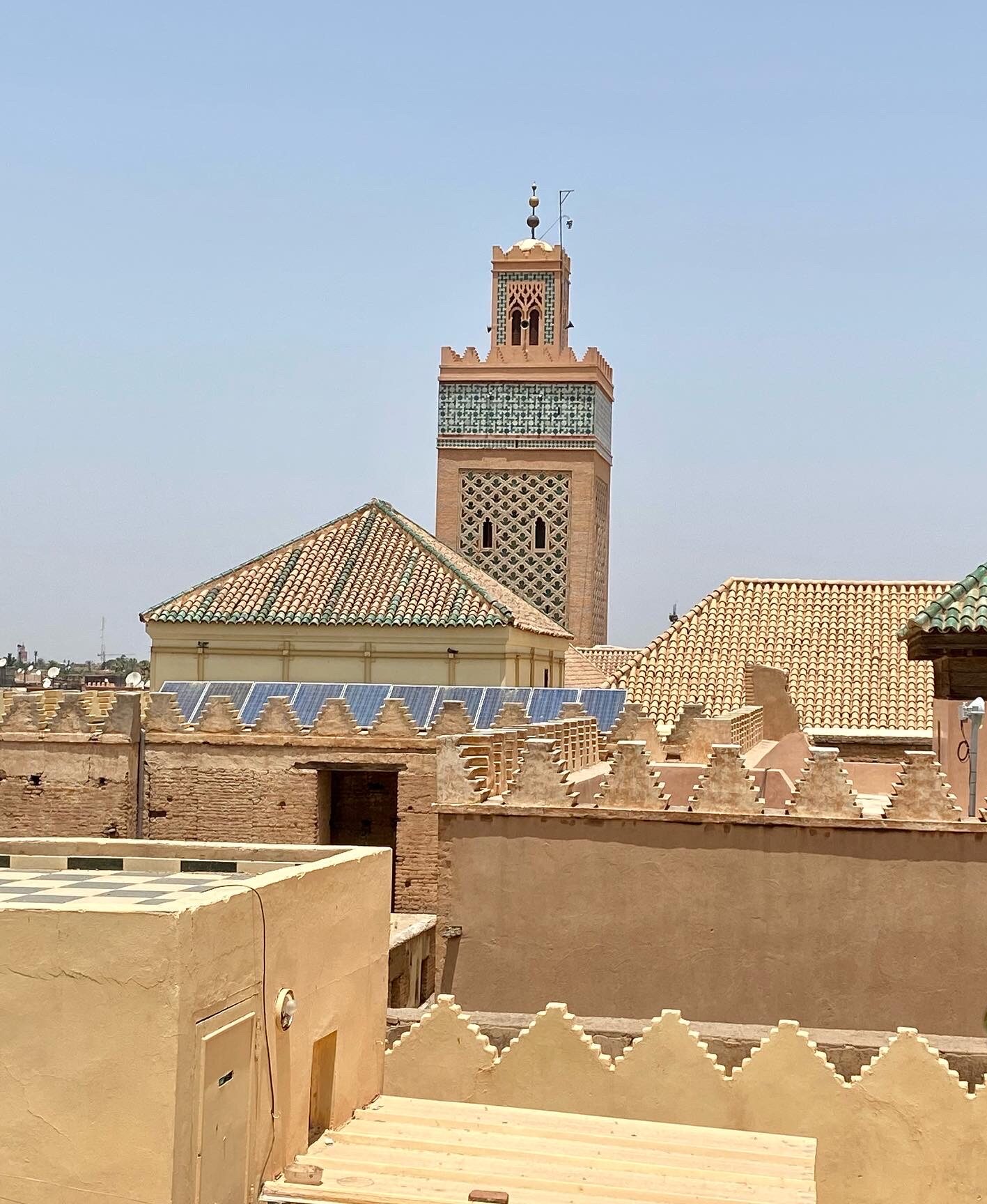
The vivid contrasts in colour you find in the souk are a feast for the eyes with all the hanging handwoven textiles and rugs, baskets, hand-painted tiles, and pottery, flowing tunics and kaftans, and especially the mesmerizing display of spices, so rich in colour and scent infusing all your senses.

Such a dramatic experience reminds us of how the influence of a culture’s subtle and, not-so-subtle energies shape the context of our lives and become a part of who we are.
These cultural mores are so powerful that they are able to carry over into modernity through architecture and design. This collaboration between the traditional and present-day naturally reveals an evolution without releasing its anchor to its soul.
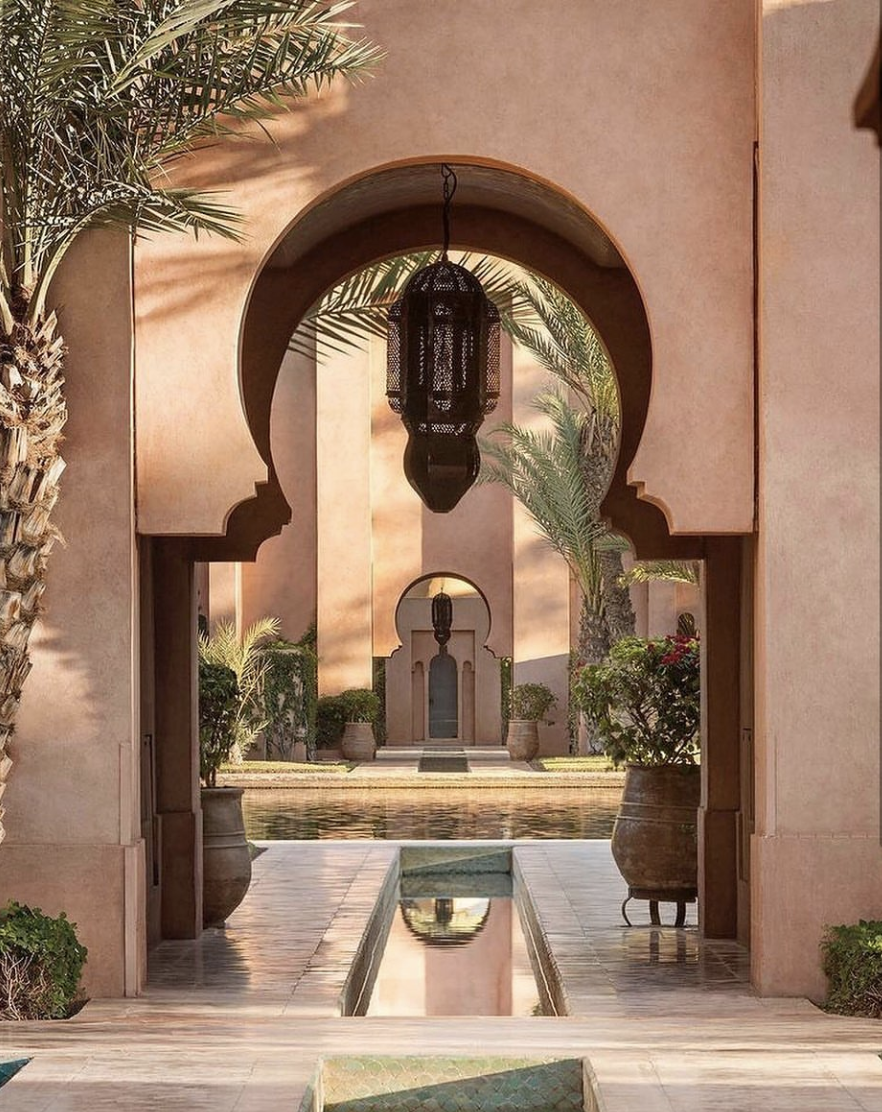
Amanjena Resort
This ennobling relationship can be seen in the medieval medina and the nouveau Marrakesh where you can have 5-star hotels that are redefining luxury experiences such as the Royal Mansour, La Mamounia, and La Sultana.
It is perhaps the reason why we find places like this so compelling because you can tangibly feel and experience the spirit of its origins.

La Sultana Marrakesh. Photo by J.Viale

Amanjena Resort
The unique qualities of these cultural shapes and symbols have become more globalized as interior trends have embraced the beauty and style of cultural tendencies. As our lives have become connected through social media, cultural designs have become very accessible and as a result, they expand the texture of our lifestyle.
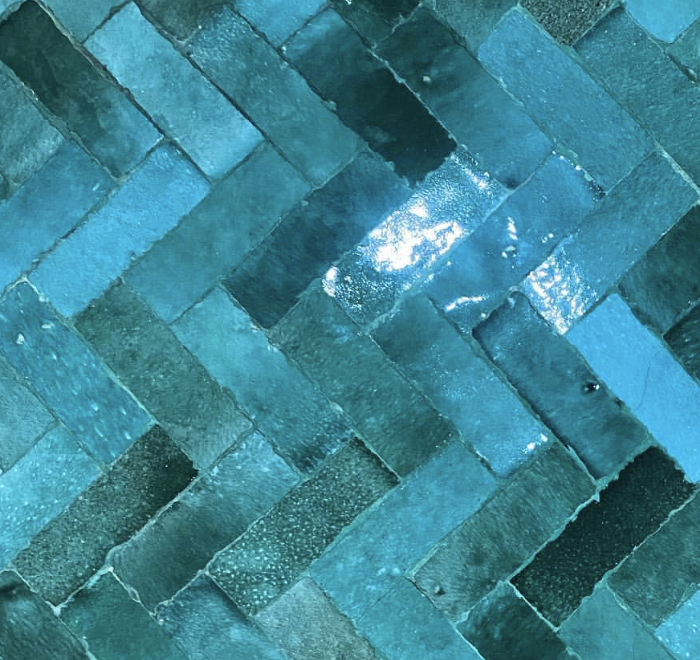
Coco Morocco
Yves Saint Laurent is a shining example of a designer whose love affair with Marrakesh, which began in 1996, inspired his fashion designs and where his dedicated contemporary Museum serves as a repository of his Moroccan-inspired designs.

Museum Yves Saint Laurent in Marrakesh
As one of the most contemporary buildings in Marrakesh designed by Studio KO and Yves Saint Laurent’s partner Pierre Bergé, it is no surprise that it also carries cultural symbolism through its walled architecture similar to that of the medina with its patterned red bricks, and contrasted with smooth marble and stone interior similar to the lining of a jacket.
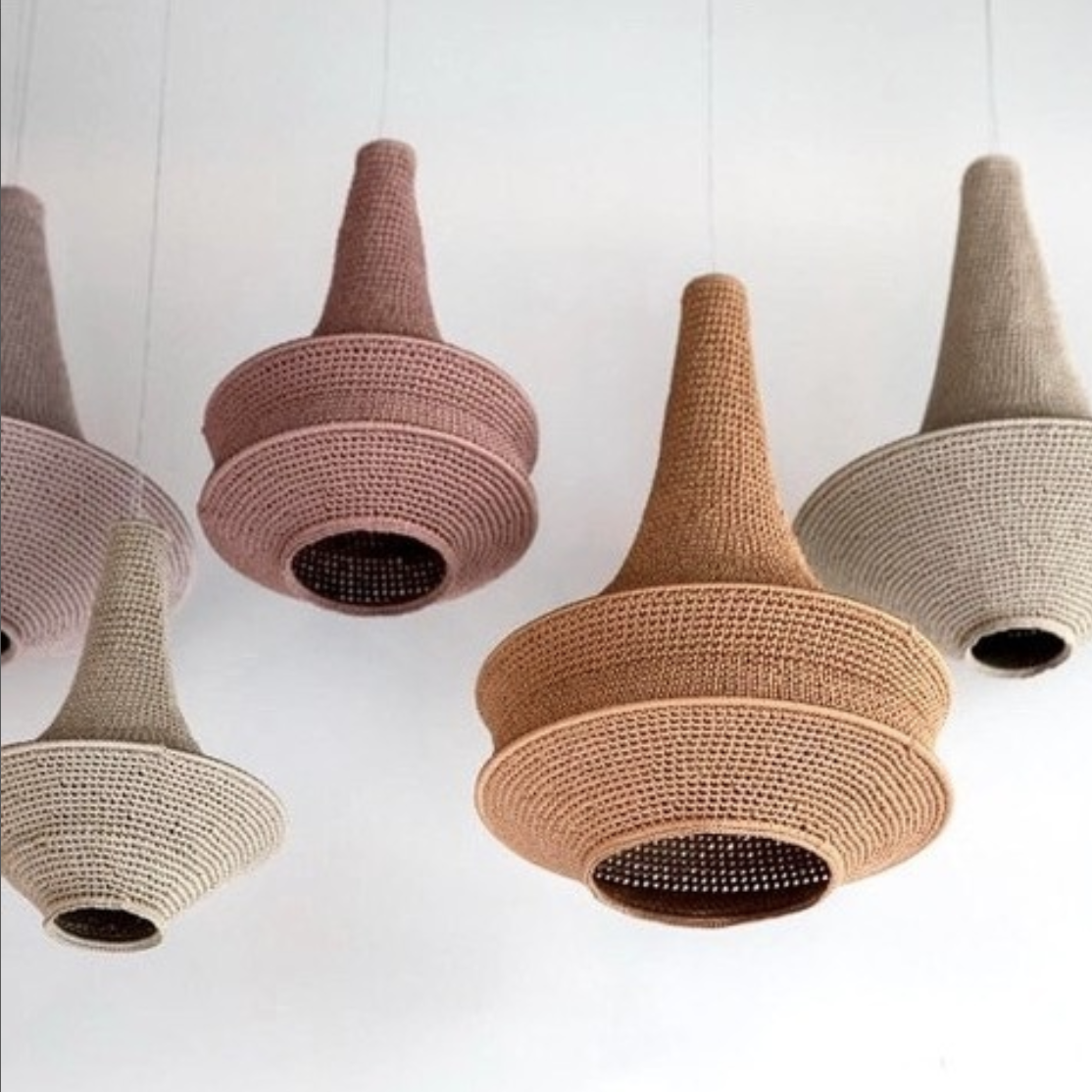
Hamimi Design
The evolution of interior design continues to flourish and we embrace these cultural sensitivities so that the line to the origins of our heritage can continue to be honoured. The unique aspects of our personalities are what gives us our individuality but also what ties us together collectively.
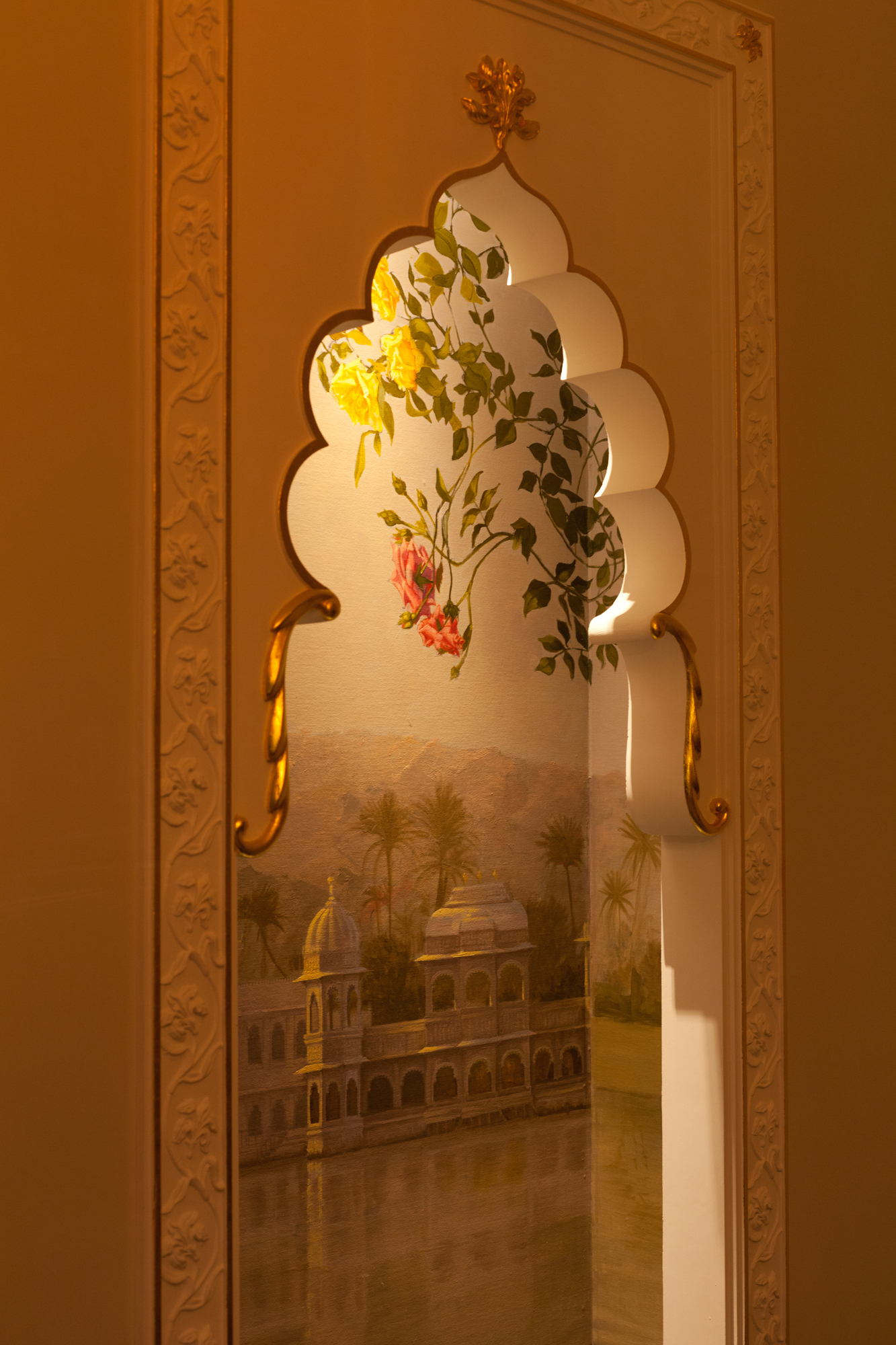
Callender Howorth project Heath Drive was culturally inspired by our client’s Indian heritage.
A Cultural Perspective
As we move toward a more conscious economy, understanding the essence of different cultures and celebrating their beauty evolves our own wisdom and produces authentic designs that preserve the lines of our origins.
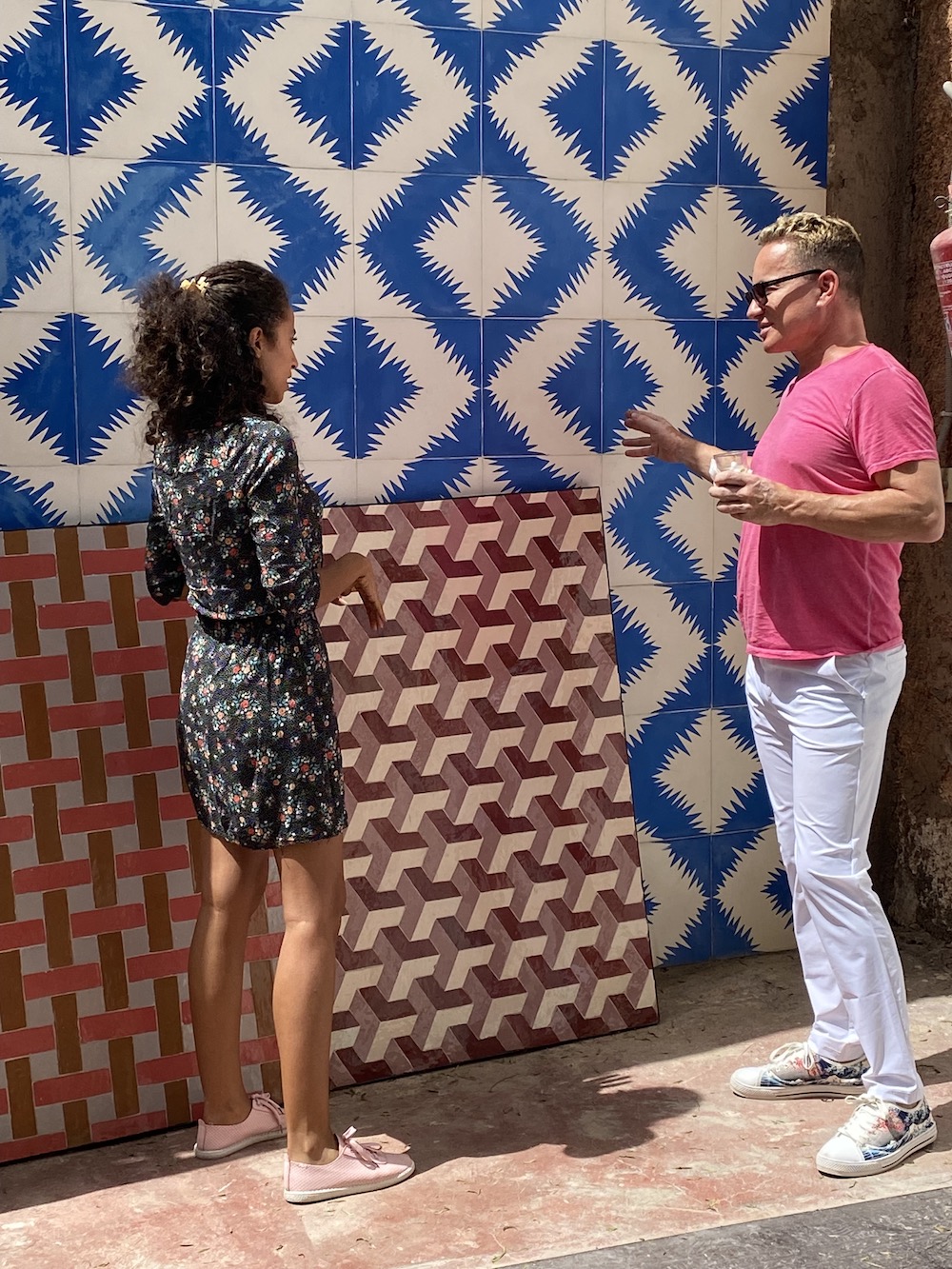
Sourcing tiles for a new project by Callender Howorth.

The selection of Moroccan rugs in Marrakesh are endless.
Callender Howorth is always looking for new ideas, inspiration and suppliers for our clients.
We are delighted to be developing some very interesting connections in Marrakesh for new suppliers for tile, rugs, metal work, lighting and of cultural authenticity for our clients who are seeking to infuse their appreciation for cultural influences in the interior design of their homes.
Cover image: moroccan.minimalism















Côte d'Azur • London • Los Angeles • New York • Paris
French Riviera Style
The French Riviera is aglow as the Cannes Film Festival and the Monaco Grand Prix have just ended with some of the world’s most recognised celebrities donning the latest designer styles and fashion.
Style is the order of the day.
Actually, every day on the French Riviera is all about style! All the cafes, beach clubs, restaurants, and chic lounges are dressed to impress including the people.
But just what is Riviera style?
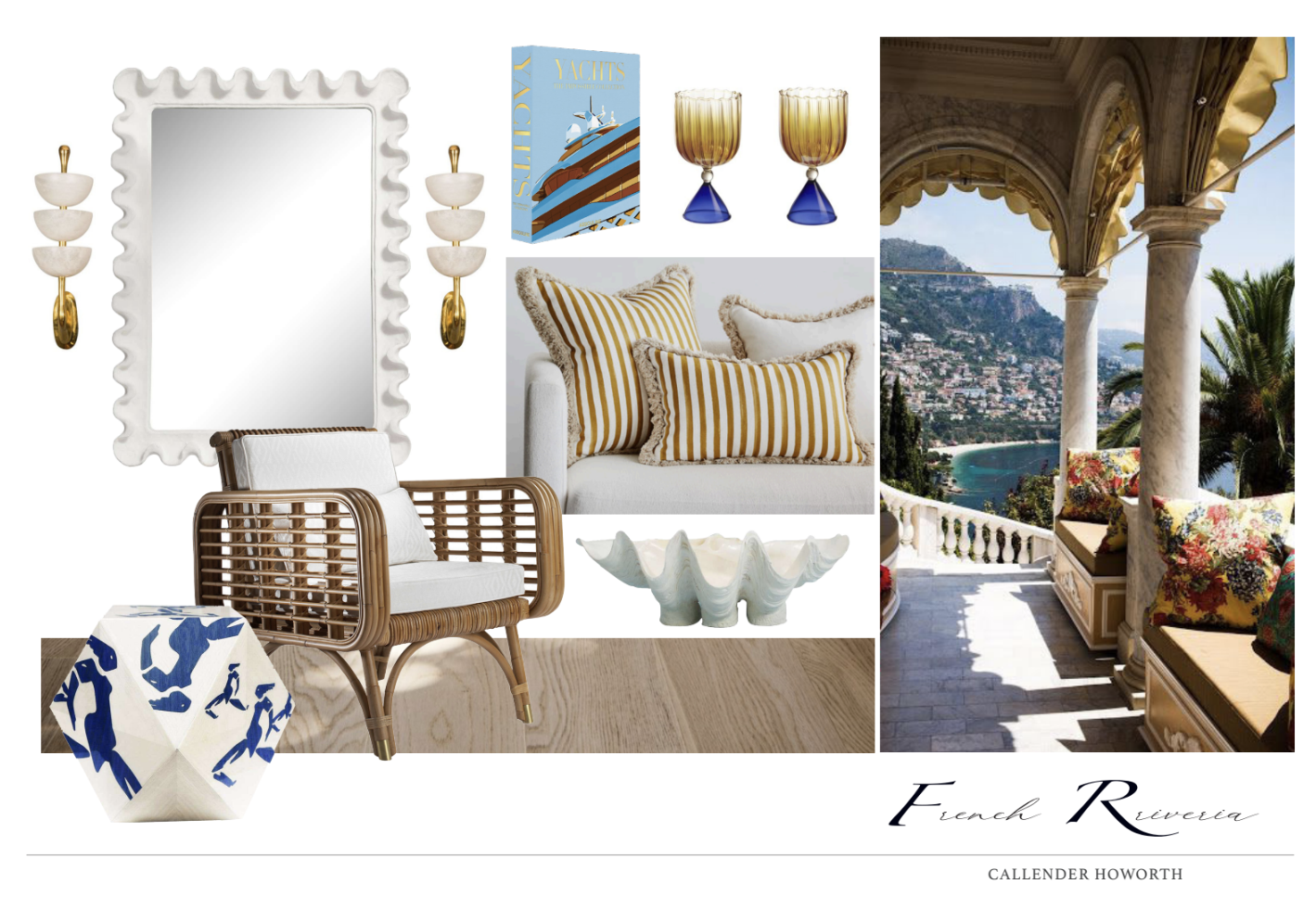
Effortless, Simple Sophistication
With the azure turquoise colour of the Mediterranean in the backdrop, charming sun-bleached frescos of the Maisons de Ville that line most of the ports and villages along the Cote d’Azur, the melange of the Provencal charm with world-class glamour and affluence infuses the subtle Mediterranean breeze.

Classic scenes such as Bridget Bardot driving the speedboat in the bay of Saint Tropez in the 1955 film “And God Created Woman” showcased a sublime French lifestyle to the world and elevated the simple fishing village of Saint Tropez as a top VIP destination. The Bardot effect, certainly.
White and Bleu
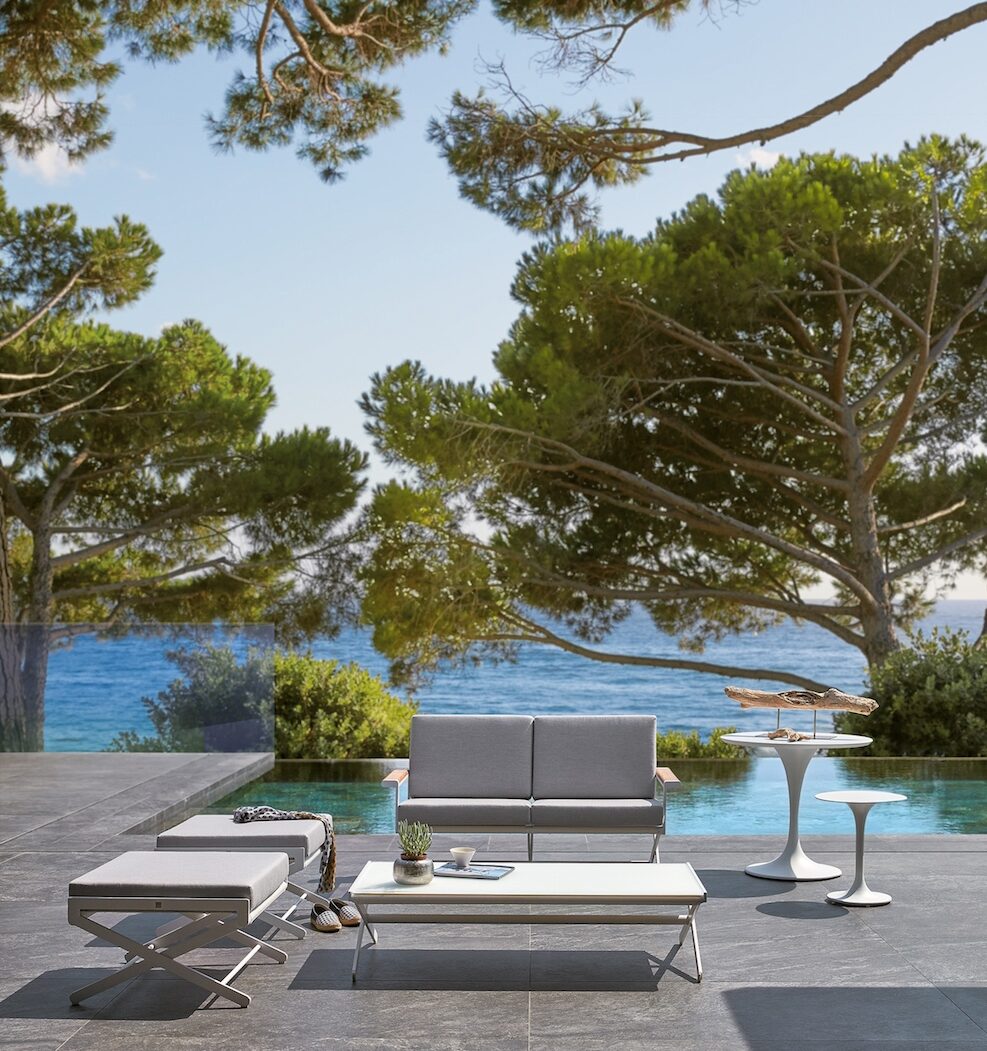
Outdoor lounge by SIFAS Outdoor Design.
From refined and minimalistic light sand and grey tones paired with white linen to nautical blue and white striped parasols and vintage Parisian Epoque in classic black and white woven bistro chairs, White is the Riviera’s signature colour when it comes to style for both decor and fashion.

The Chaises Bleu ( The blue chairs) are the iconic signature of the Promenade des Anglais in Nice.
The shades of azure blue is the precious inspiration of the Mediterranean sea.
From the signature chaise bleu of the Promenade des Anglais and on the Croisette in Cannes, you will find an ode to this pristine blue everywhere along the Cote d’Azur.
The essence of this colour palette is where we draw our inspiration from for our interior design projects on the Cote d’Azur.
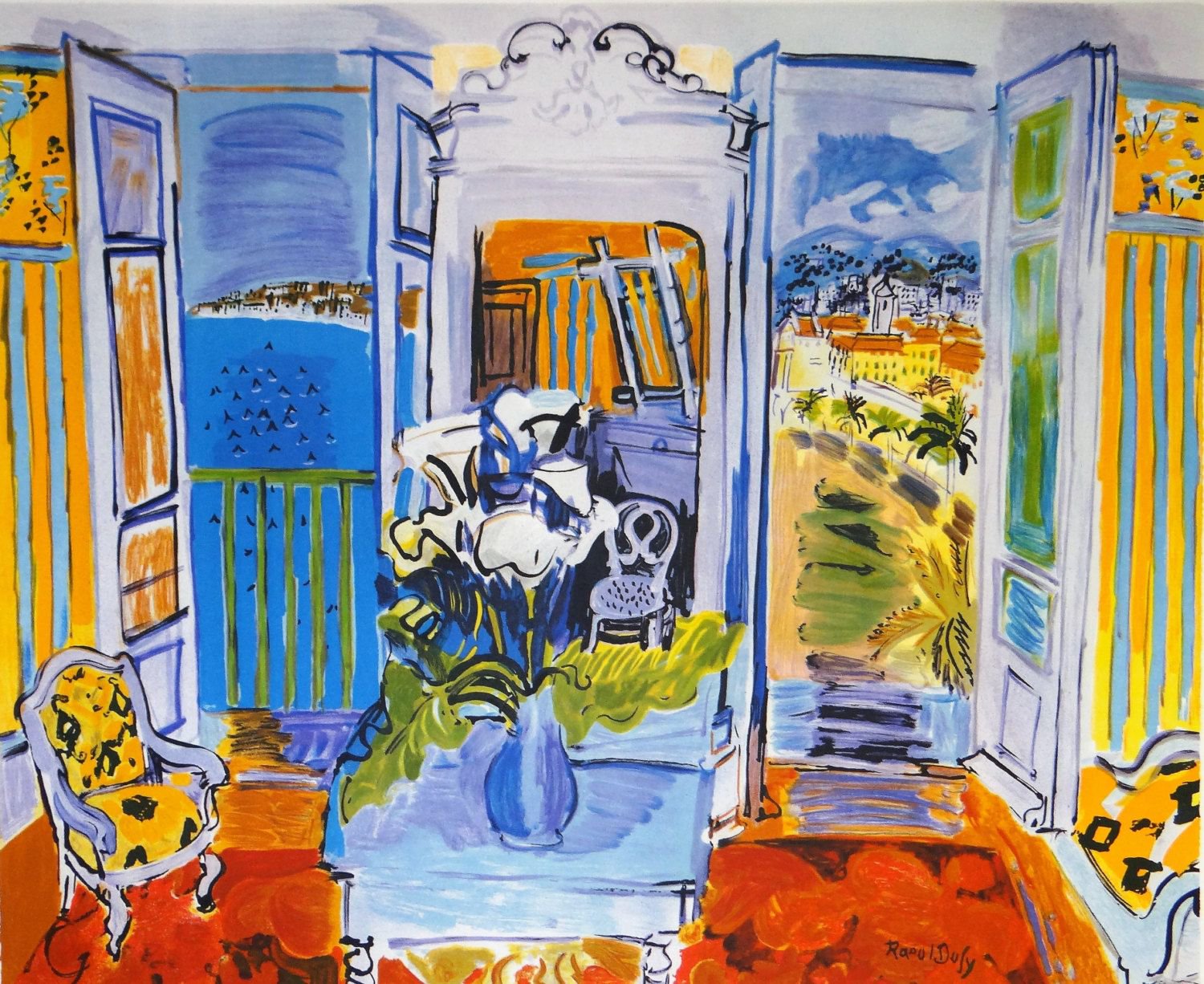
Raoul Dufy’s 1928 “Intérieur à la fenêtre ouverte” depicts the view of the Baie des Anges in Nice.
Artists like Picasso, Matisse, Chagall and Dufy were also all drawn to the Riviera for its bright luminosity that were depicted in their famous works of art.

Anjuna Plage in Eze sur Mer, a favourite local seaside eatery where we often lunch with our clients.
Rooted in Provencal Charm
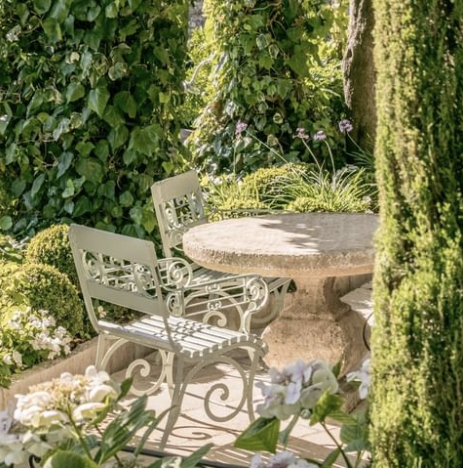
Whether you are seaside or countryside, the Provencal charm is tied to the territory through the simple architecture, agriculture and gardening, nature, cuisine, and joie de vivre.
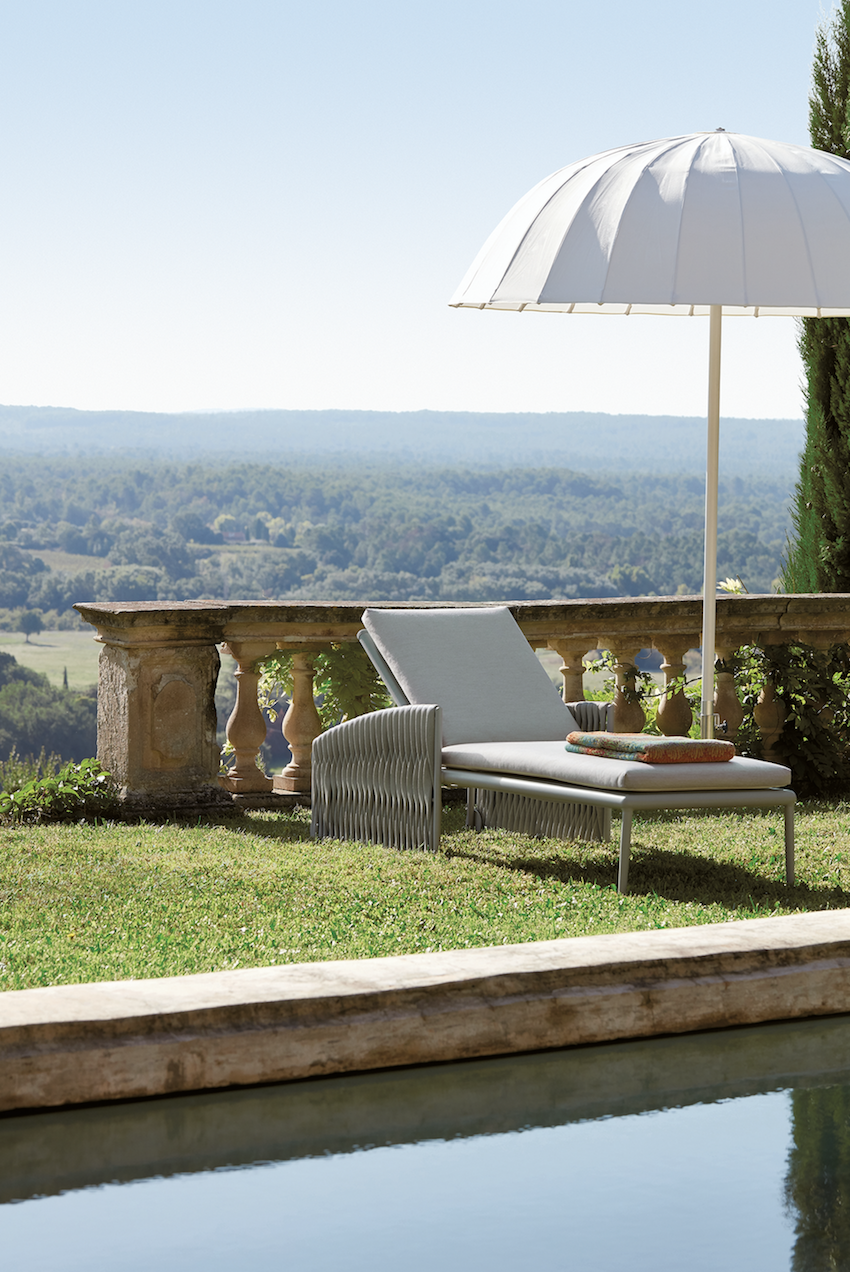
Photo by SIFAS.
The joy is in appreciating the simplicity because the surroundings speak for themselves with their natural beauty.
Dining al fresco under the pergola of wisteria with friends and family, and enjoying locally grown products like olive oils, cheeses, and wine in connection to this coveted Mediterranean territory.
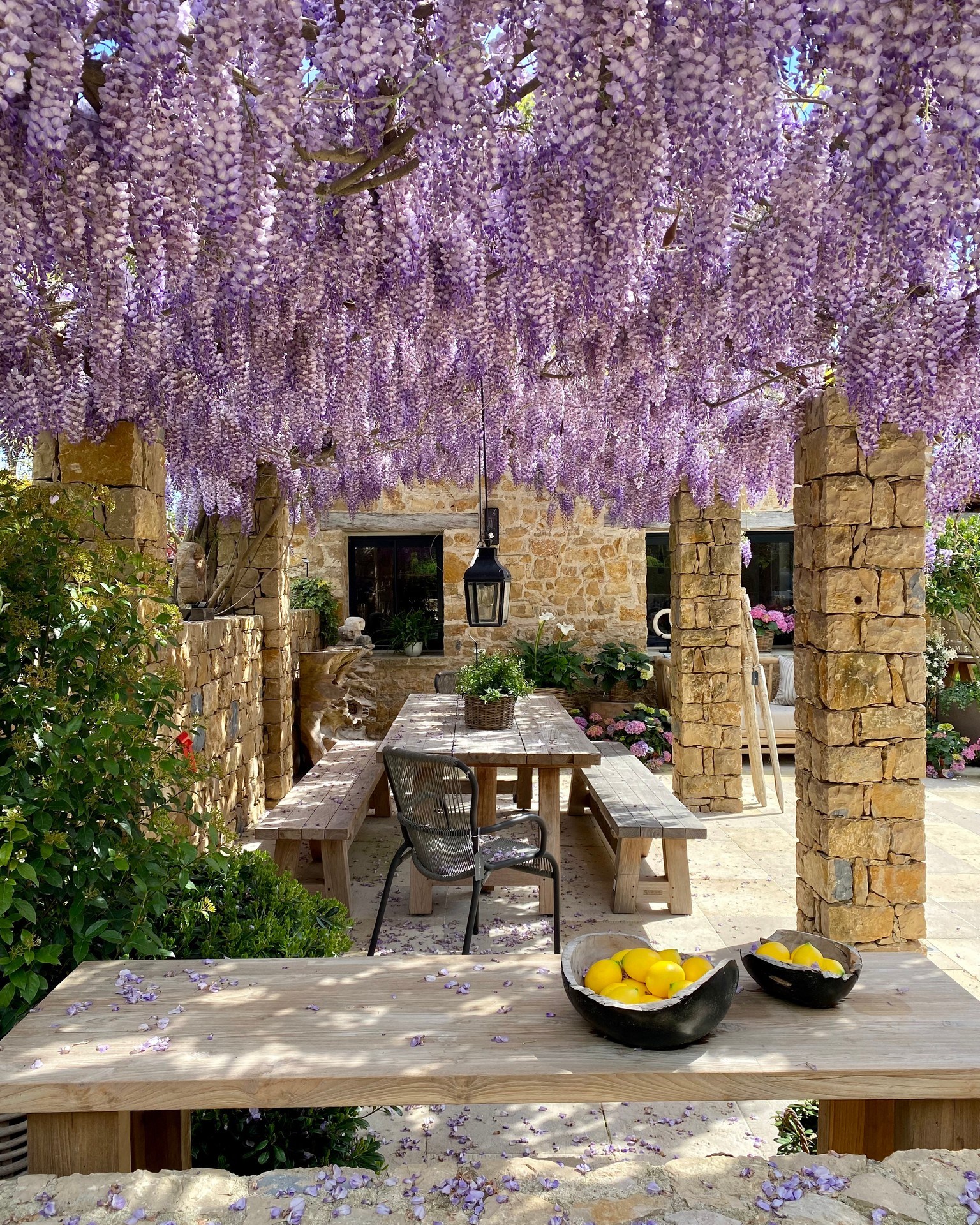
Callender Howorth works with English Garden Group to create memorable outdoor landscapes and living areas.
Irrefutable Elegance and Class
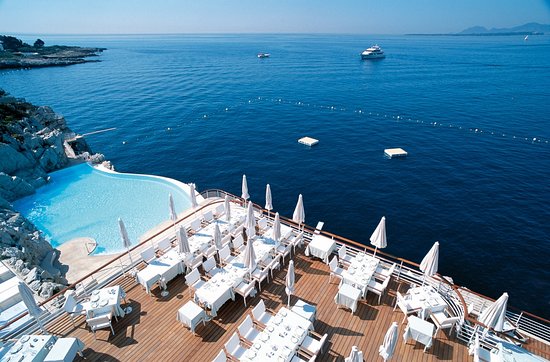
Photo by Hotel du Cap Eden Roc
The French Riviera heralds some of the most beautiful hotels with undeniable elegance and class such as the Hotel du Cap Eden Roc nestled in the rugged scenic coastline of Cap d’Antibes.
A timeless legend of carefree elegance and inspirational beauty.

Photo by Carlton Beach Club.
During the Cannes Film Festival, A-list celebrities and film are usually spotted in the Carlton Beach Club soaking in the Mediterranean sun.
A Lifestyle of Outdoor Living
A signature mark of living on the French Riviera is the year long indoor/outdoor living lifestyle.
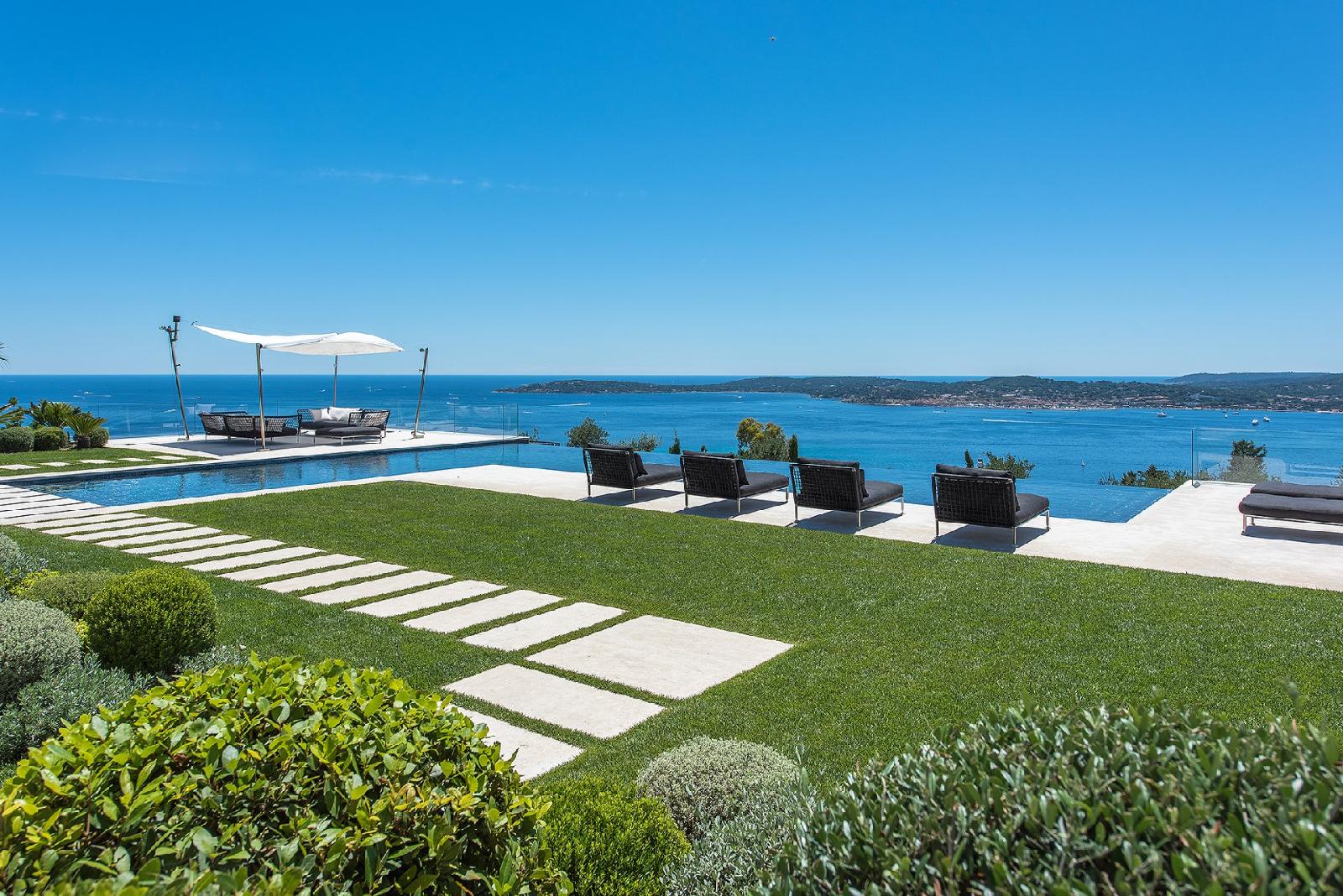
Photo by Carlton-International. Luxury seaside property in Grimaud, St. Tropez’s quiet neighbour.
Touting 300 days of sunshine a year, the most exclusive homes are designed with the intention of enjoying the glorious sunny weather all year. The focal point is the terrace, whether is a sea view terrace or niched in the Provencal countryside.
The natural lighting of the Riviera is quite unique which makes designing the interiors of luxury homes quite interesting in that the interior lighting designs complement the vast arrays of ever changing natural light streams.

Photo by English Garden Group. Sunken lounge for a cozy night under the stars.
The French Riviera is a distinct blend of old and new, a harmonious contrast that carries with it an inspiring carefree spirit.
Perhaps the French way of admiring the simple things in life such as a beautiful flower market like the Cours Saleya in Nice, an afternoon pause for an espresso al fresco or a seaside aperitif to watch the sunset, reminds us of the beauty of the simple pleasures and making simple pleasures beautiful.
Here is a sneak peak of our current project for a sea view villa in Villefranche-sur-mer.
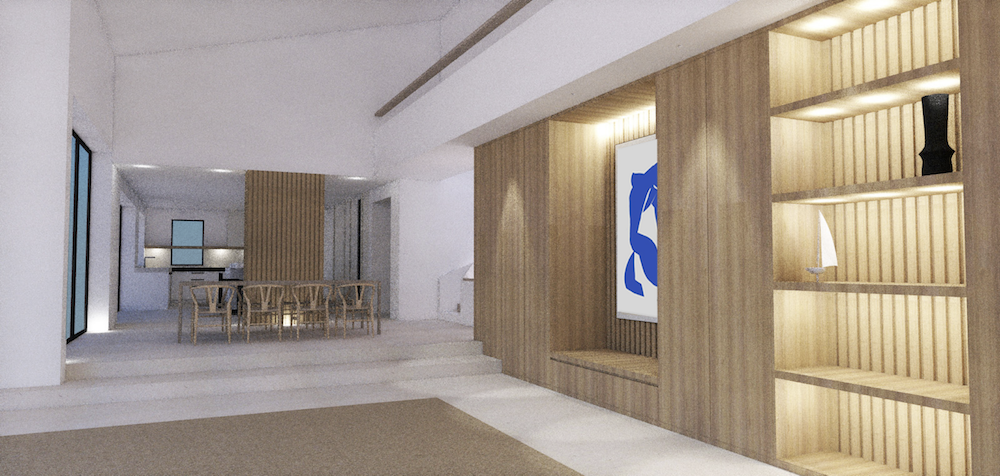
Rendering by Callender Howorth for current project in Villefranche-sur-mer.
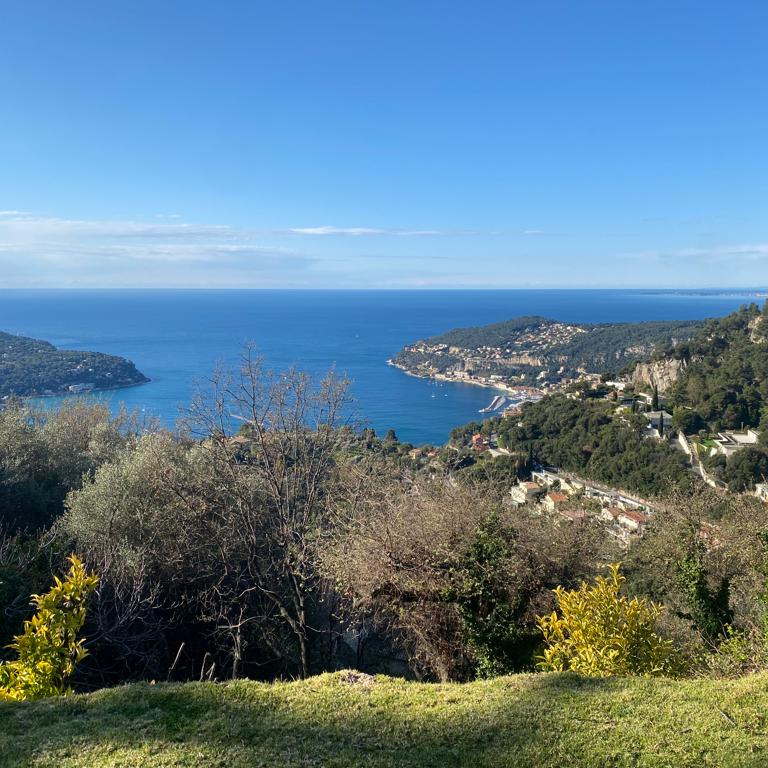
View of the bay of Villefranche from Callender Howorth’s renovation project for a luxury villa.
For our projects in the south of France we infuse this essence of enjoyment along with the energy of refined organic materials and natural light to create living spaces whose beauty and comfort are effortless.
Whether you are having a picnic on the beach, 5-star fine dining, or renovating your home, the essence of Riviera style is in the effortless spirit of enjoyment.















Côte d'Azur • London • Los Angeles • New York • Paris
Styling in New York
It’s such a nice feeling to be back in New York now that travel has opened back up again.
Perhaps it’s a newfound appreciation of life moving forward after the pandemic, but the city seems more vibrant than ever!
Central Park
As we work on an interior design project for a penthouse in Central Park South, we find ourselves gazing out to the gorgeous views of Central Park and how the beauty of this park, an icon of the New York lifestyle, plays such an important role to New Yorkers.
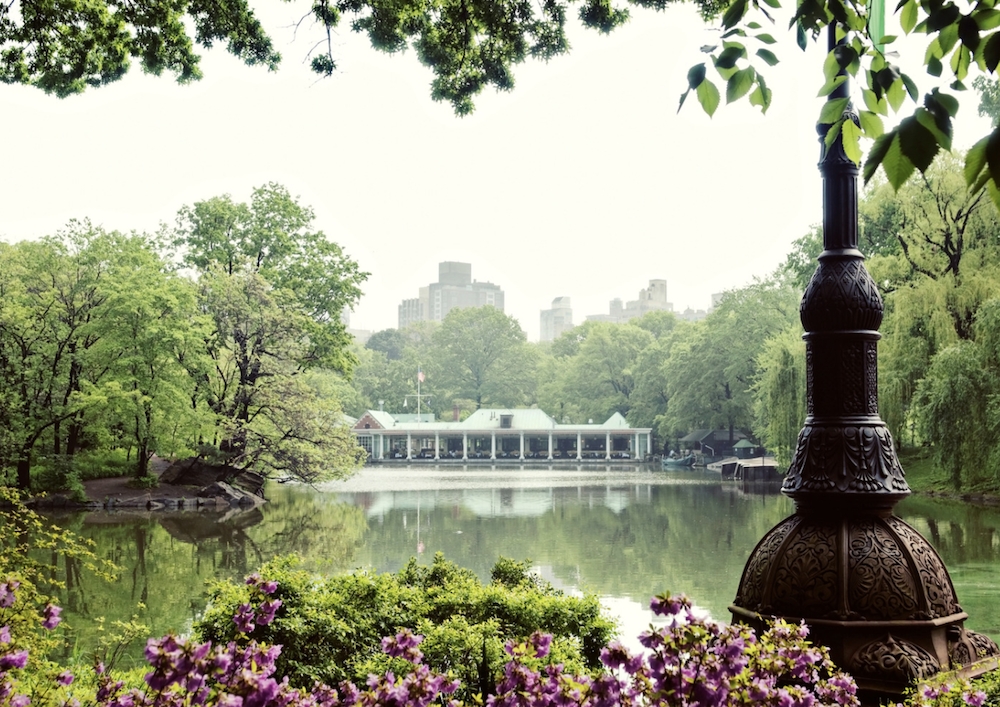
The romantic setting of the charming Loeb Boathouse.
Apart from the classic horse and carriage rides that appeared in so many films made in New York, Central Park is an urban oasis of activities like feeding the penguins at the Central Park Zoo to Sunrise Morning Yoga Walks, winter Ice skating at Wollman Rink, to the landmark charm of lunching at Tavern on the Green or dining lakeside in the romantic setting of the Loeb Boathouse.
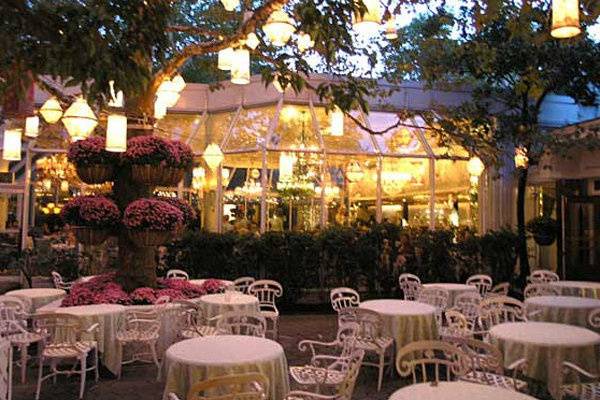
Central Park’s classy landmark restaurant Tavern on the Green.
The elegant charm of Manhattan underpins the beauty of Central Park, and as we begin working on another penthouse project here, we can’t help but hear Sinatra’s signature melody New York, New York! Campy, but it gets us every time !

Callender Howorth penthouse interiors project in Central Park South.
Styling for this project will capture timeless elegance while being easy and effortless to live in.
The apartment will reflect our client’s signature unique style while reflecting the sophistication of the Central Park lifestyle.
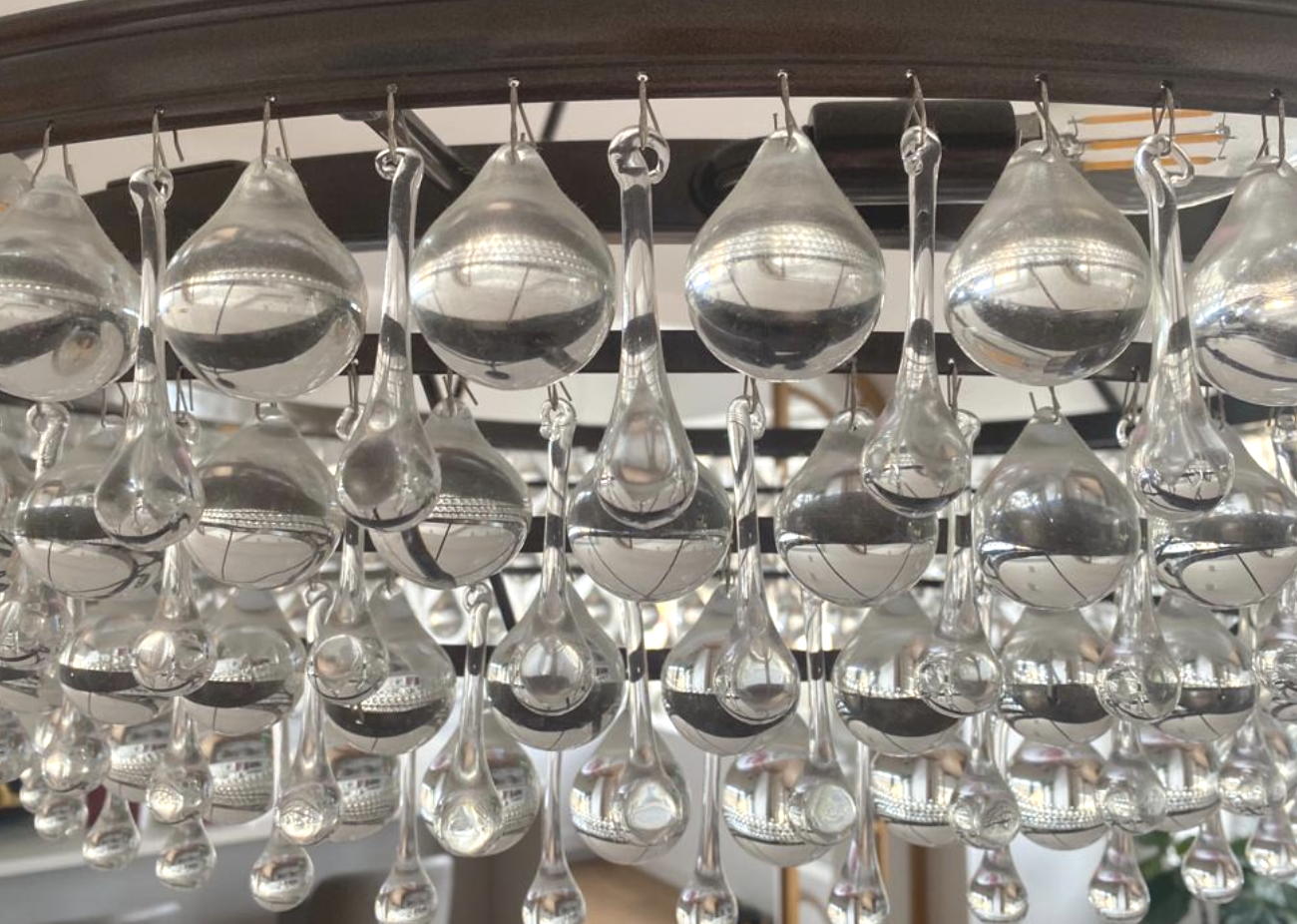
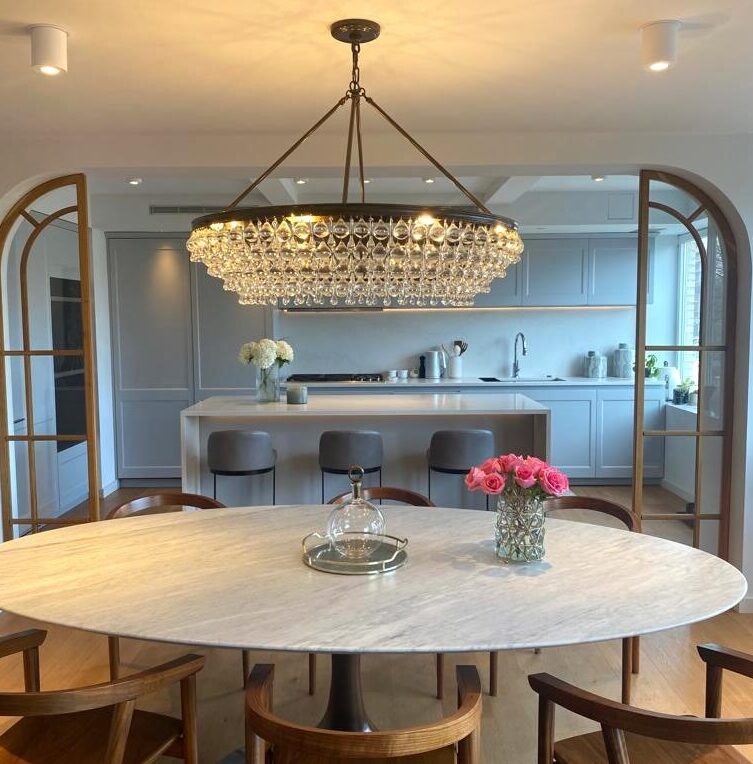
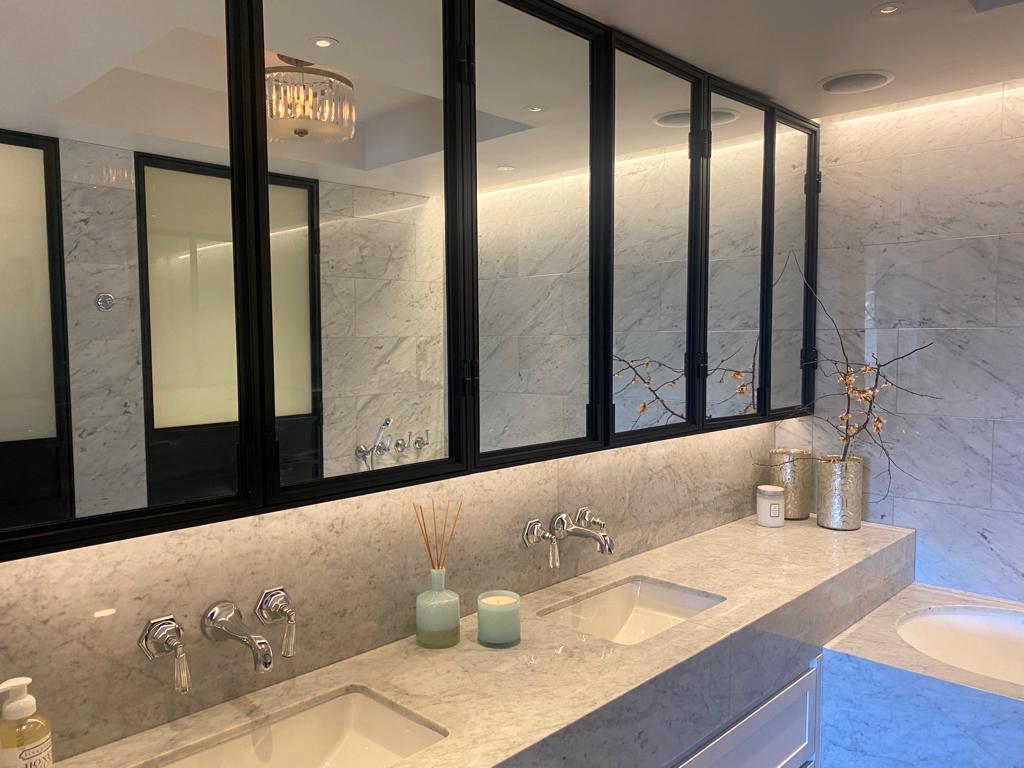
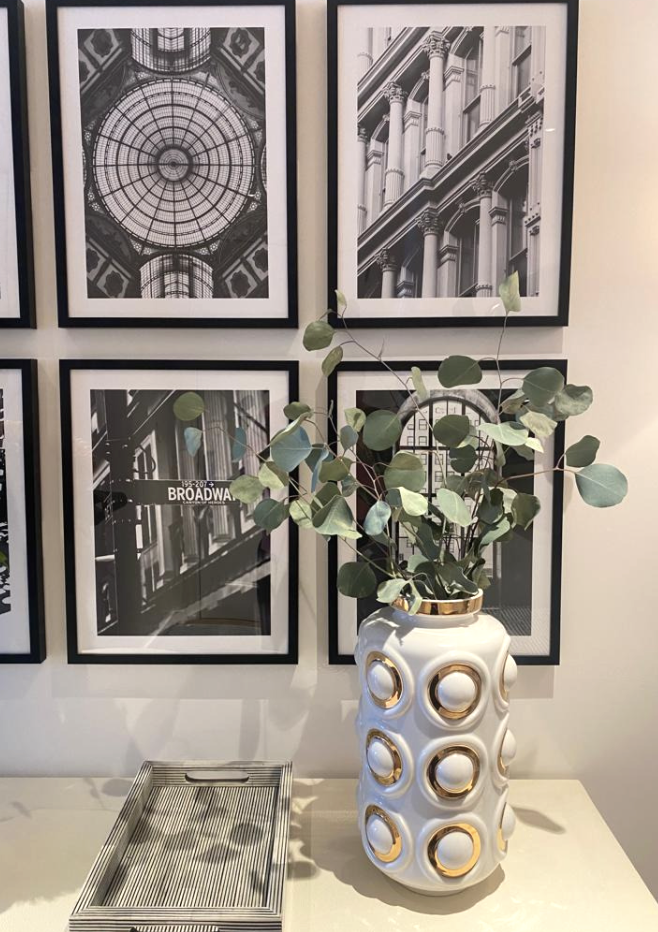
The Hamptons
The second part of our trip takes us to the Hamptons in Long Island.
Known as a rural summer getaway from the city for the rich and famous, the homes on the Hamptons are as famous as the hedgerows that hide them as well as the perennial American Beach Grass of the East End.

As we work on an interior residential project here, we can feel the relaxed and laid-back atmosphere of coastal living. The coastal breezes, quaint village shops, gourmet farmers’ markets, flower shops, and stylish boutiques all carry the underlying grace and grandeur of living in the Hamptons.
Our residential interiors project will combine the essence of refinement and class with the ease of understated elegance as a thread to the natural charm of its coastal environment.
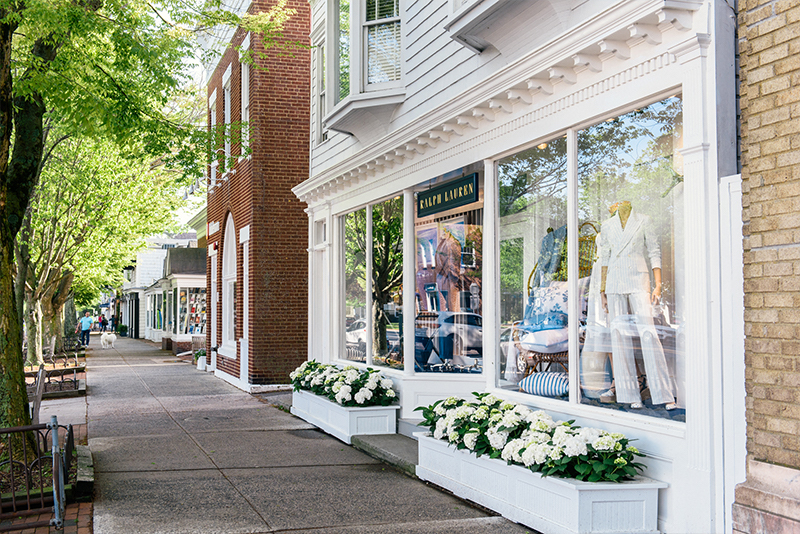
Classic village elegance in Southampton.
Whilst the contrast of the Hamptons with Central Park is palpable, the proud American spirit is what ties them together. Much like back in the UK where the British sentiment and spirit reign supreme in its traditions and style.
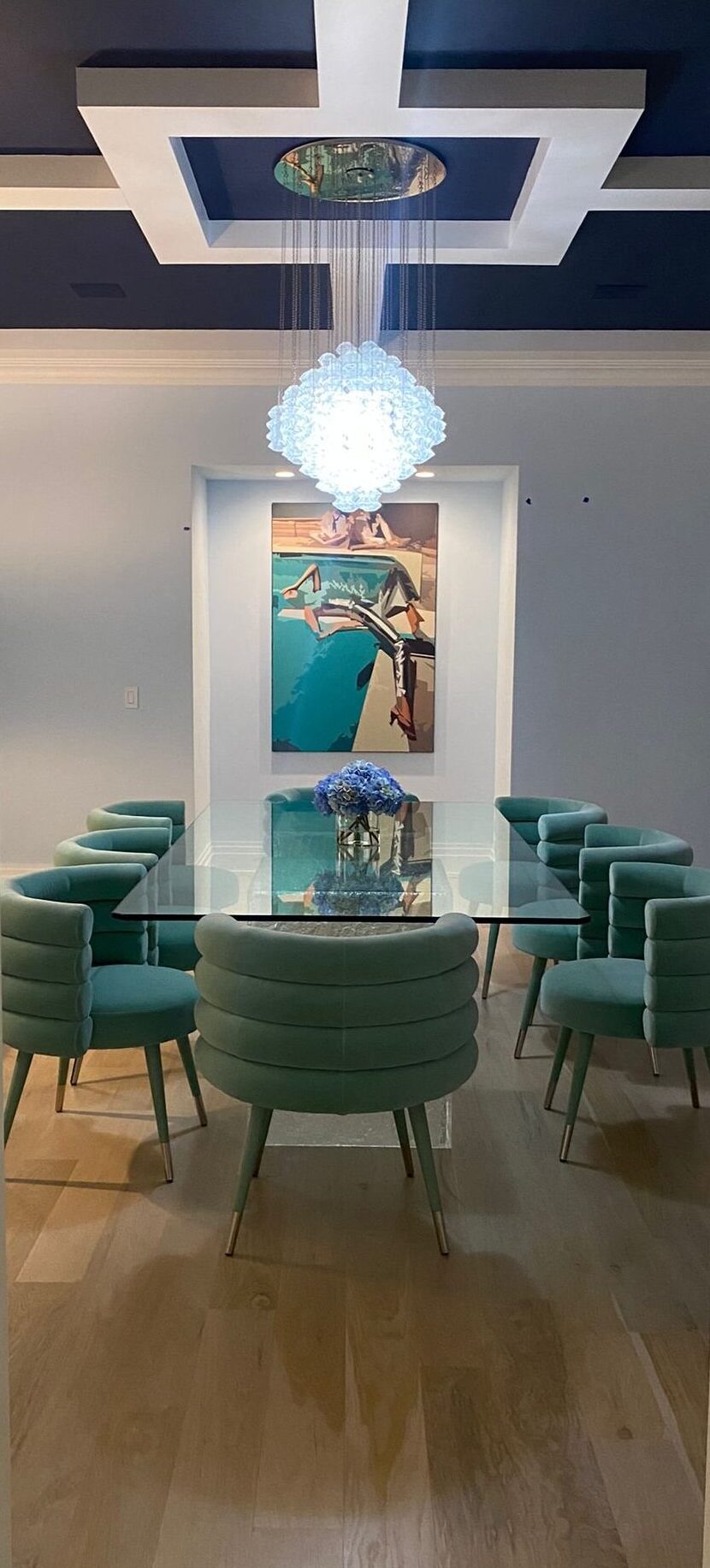
Callender Howorth’s residential interior project in Southampton.
As we continue the completion of our current projects Central Park and the Hamptons, we are beginning to prepare the next round of projects in these famed areas of New York.
Luxury Interior Designers & Architects in London
Callender Howorth © 1997-2026
